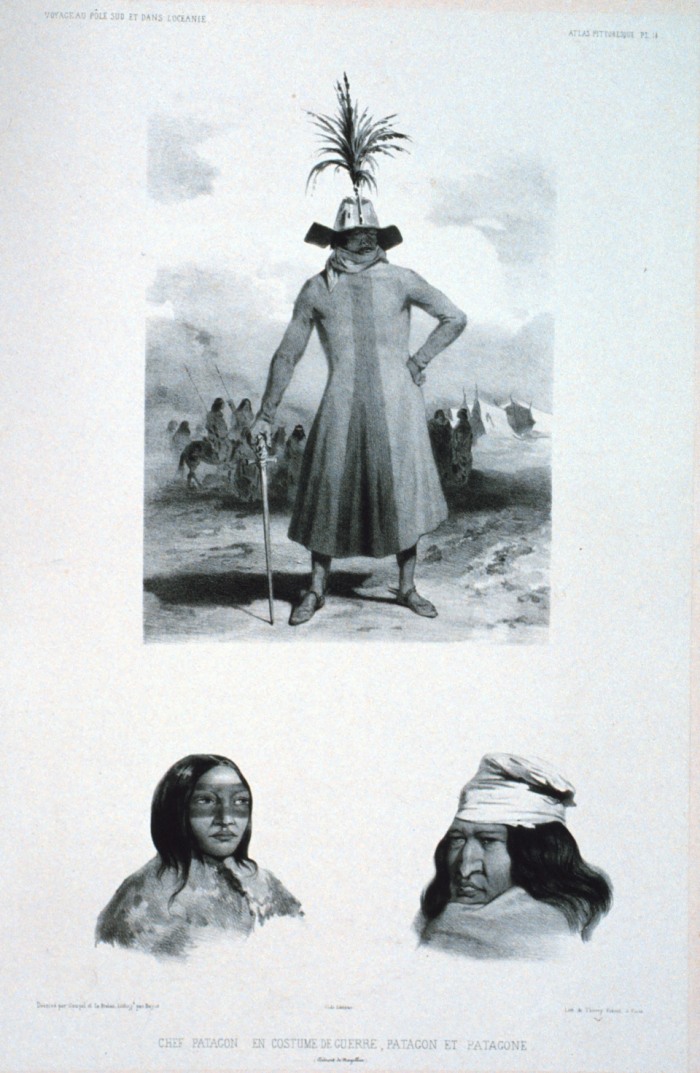
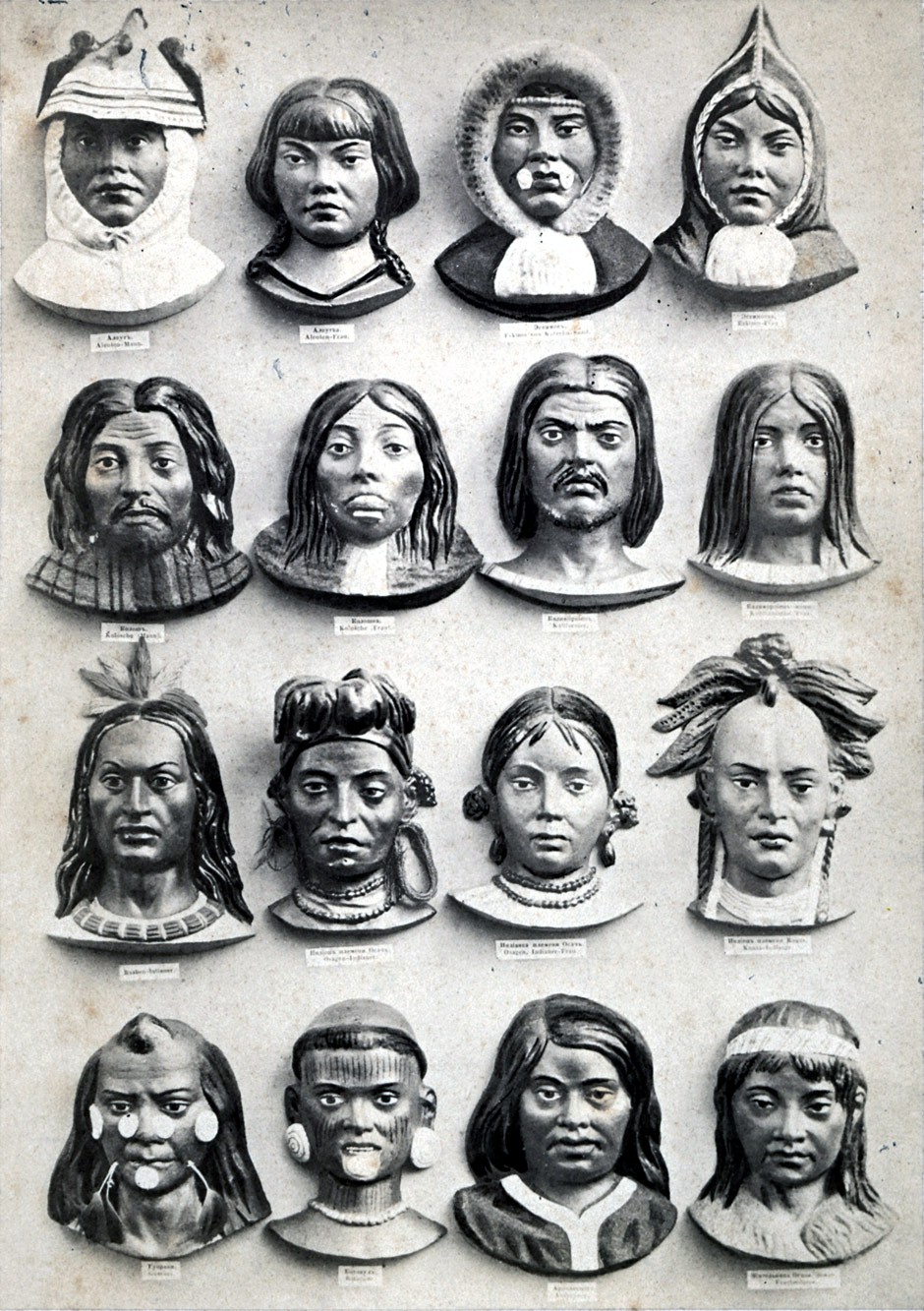

科学人種主義の歴史
History of Scientific Racism
Jules Dumont
d'Urville / / Karl Ernst von Bear(1862)
★人種は、科学的概念ではなくて、人の集団を区別し、そこに序列を見出す政治的イデオロギーである。
☆ 科学人種主義(Scientific racism)あるいは生物学的人種主義(biological racism)は、 人種(レイス)の区分にもとづく、人種主義(人 種差別・レイシズム)、人種的劣等性、あるいは人種的優越性を支持するか正当化するた め、科学的言説——真正性の概念に照らせば「擬似科学的信念(pseudoscientific belief)」が動員される——科学的に偽装された価値判断としての人種主義のことである。
以下は、科 学人種主義の歴史である(→「科学人種主義・科学レイシズム」「科学的人種主義講義」より、こちらにスピンオン)
| Scientific
racism,
sometimes termed biological racism, is the pseudoscientific belief that
the human species can be subdivided into biologically distinct taxa
called "races",[1][2][3] and that empirical evidence exists to support
or justify racism (racial discrimination), racial inferiority, or
racial superiority.[4][5][6][7] Before the mid-20th century, scientific
racism was accepted throughout the scientific community, but it is no
longer considered scientific.[5][6] The division of humankind into
biologically separate groups, along with the assignment of particular
physical and mental characteristics to these groups through
constructing and applying corresponding explanatory models, is referred
to as racialism, race realism, or race science by those who support
these ideas. Modern scientific consensus rejects this view as being
irreconcilable with modern genetic research.[8] Scientific racism misapplies, misconstrues, or distorts anthropology (notably physical anthropology), craniometry, evolutionary biology, and other disciplines or pseudo-disciplines through proposing anthropological typologies to classify human populations into physically discrete human races, some of which might be asserted to be superior or inferior to others. Scientific racism was common during the period from the 1600s to the end of World War II, and was particularly prominent in European and American academic writings from the mid-19th century through the early-20th century. Since the second half of the 20th century, scientific racism has been discredited and criticized as obsolete, yet has persistently been used to support or validate racist world-views based upon belief in the existence and significance of racial categories and a hierarchy of superior and inferior races.[9] After the end of World War II, scientific racism in theory and action was formally denounced, especially in UNESCO's early antiracist statement, "The Race Question" (1950): "The biological fact of race and the myth of 'race' should be distinguished. For all practical social purposes, 'race' is not so much a biological phenomenon as a social myth. The myth of 'race' has created an enormous amount of human and social damage. In recent years, it has taken a heavy toll in human lives, and caused untold suffering."[10] Since that time, developments in human evolutionary genetics and physical anthropology have led to a new consensus among anthropologists that human races are a sociopolitical phenomenon rather than a biological one.[11][12][13][14] The term scientific racism is generally used pejoratively when applied to more modern theories, such as those in The Bell Curve (1994). Critics argue that such works postulate racist conclusions, such as a genetic connection between race and intelligence, that are unsupported by available evidence.[15] Publications such as the Mankind Quarterly, founded explicitly as a "race-conscious" journal, are generally regarded as platforms of scientific racism, because they publish fringe interpretations of human evolution, intelligence, ethnography, language, mythology, archaeology, and race. |
科学的人種主義(生物学的人種主義と呼ばれることもある)とは、ヒトと
いう種は「人種」と呼ばれる生物学的に異なる分類群に細分することができ[1][2][3]、人種主義(人種差別)、人種的劣等性、人種的優越性を支持ま
たは正当化する経験的証拠が存在するという偽科学的信念である[4][5][6][7]。20世紀半ば以前は科学的人種主義は科学界全体で受け入れられて
いたが、現在では科学的とは考えられていない。
[5][6]人類を生物学的に別個の集団に分割し、対応する説明モデルを構築し適用することによってこれらの集団に特定の身体的・精神的特徴を割り当てる
ことは、これらの考えを支持する人々によって人種主義、人種実在論、または人種科学と呼ばれている。現代の科学的コンセンサスは、現代の遺伝子研究と両立
しないとしてこの見解を否定している[8](→「科学的人種主義」)。 科学的人種主義は、人類学(特に身体人類学)、頭蓋計測学、進化生物学、その他の学問や疑似学問を誤用、誤解、歪曲しており、人類学的類型論を提唱するこ とで、人間の集団を物理的にバラバラの人種に分類し、その一部は他の人種よりも優れている、あるいは劣っていると主張する。科学的人種差別は1600年代 から第二次世界大戦の終わりまで一般的であり、特に19世紀半ばから20世紀初頭にかけてのヨーロッパやアメリカの学術論文で顕著であった。20世紀後半 以降、科学的人種主義は否定され、時代遅れであると批判されてきたが、人種的カテゴリーの存在と重要性、優劣のある人種のヒエラルキーの信念に基づく人種 主義的世界観を支持または正当化するために根強く使用されてきた[9]。 第二次世界大戦の終結後、理論と行動における科学的人種主義は、特にユネスコの初期の反人種主義的声明「人種問題」(1950年)において正式に非難され た: 人種という生物学的事実と "人種 "という神話は区別されるべきである。人種という生物学的事実と "人種 "という神話は区別されるべきである。社会的に実用的な目的のためには、"人種 "は生物学的現象というよりも社会的神話である。人種』という神話は、人間的にも社会的にも莫大な損害をもたらした。近年、それは人命に大きな犠牲を払 い、計り知れない苦しみを引き起こしている」[10]。それ以来、人類進化遺伝学と身体人類学の発展により、人類学者の間では、人間の人種は生物学的なも のというよりもむしろ社会政治的な現象であるという新たなコンセンサスが形成されている[11][12][13][14]。 科学的人種主義という言葉は、『ベル・カーブ』(1994年)のような、より現代的な理論に適用される場合、一般的に侮蔑的に使われる。批評家たちは、こ のような作品は人種と知能の間の遺伝的関連性など、利用可能な証拠によって裏付けられていない人種差別的な結論を仮定していると主張している[15]。人 種を意識した」雑誌として明確に創刊されたMankind Quarterlyのような出版物は、人類の進化、知能、民族学、言語、神話、考古学、人種に関するフリンジ的な解釈を掲載しているため、一般的に科学的 人種差別のプラットフォームとみなされている。 |
| Antecedents Enlightenment thinkers During the Age of Enlightenment (an era from the 1650s to the 1780s), concepts of monogenism and polygenism became popular, though they would only be systematized epistemologically during the 19th century. Monogenism contends that all races have a single origin, while polygenism is the idea that each race has a separate origin. Until the 18th century, the words "race" and "species" were interchangeable.[16] François Bernier 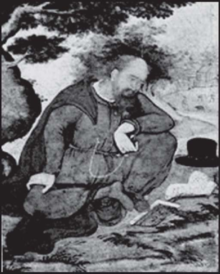 François Bernier (1620–1688) was a French physician and traveller. In 1684, he published a brief essay dividing humanity into what he called "races," distinguishing individuals, and particularly women, by skin color and a few other physical traits. The article was published anonymously in the Journal des Savants, the earliest academic journal published in Europe, and titled "New Division of the Earth by the Different Species or 'Races' of Man that Inhabit It."[17] In the essay, he distinguished four different races: 1) The first race included populations from Europe, North Africa, the Middle East, India, south-east Asia, and the Americas; 2) the second race consisted of the sub-Saharan Africans; 3) the third race consisted of the east- and northeast Asians; and, 4) the fourth race were Sámi people. A product of French salon culture, the essay placed an emphasis on different kinds of female beauty. Bernier emphasized that his novel classification was based on his personal experience as a traveler in different parts of the world. Bernier offered a distinction between essential genetic differences and accidental ones that depended on environmental factors. He also suggested that the latter criterion might be relevant to distinguish sub-types.[18] His biological classification of racial types never sought to go beyond physical traits, and he also accepted the role of climate and diet in explaining degrees of human diversity. Bernier had been the first to extend the concept of "species of man" to racially classify the entirety of humanity, but he did not establish a cultural hierarchy between the so-called 'races' that he had conceived. On the other hand, he clearly placed white Europeans as the norm from which other 'races' deviated.[19][18] The qualities which he attributed to each race were not strictly Eurocentric, because he thought that peoples of temperate Europe, the Americas, and India—although culturally very different from one another—belonged to roughly the same racial group, and he explained the differences between the civilizations of India (his main area of expertise) and Europe through climate and institutional history. By contrast, he emphasized the biological difference between Europeans and Africans, and made very negative comments towards the Sámi (Lapps) of the coldest climates of Northern Europe,[19] and about Africans living at the Cape of Good Hope. For example, Bernier wrote: "The 'Lappons' compose the 4th race. They are a small and short race with thick legs, wide shoulders, a short neck, and a face that I don't know how to describe, except that it's long, truly awful, and seems reminiscent of a bear's face. I've only ever seen them twice in Danzig, but according to the portraits I've seen, and from what I've heard from a number of people, they're ugly animals."[20] The significance of Bernier's ideology for the emergence of what Joan-Pau Rubiés called the "modern racial discourse" has been debated, with Siep Stuurman considering it the beginning of modern racial thought,[19] while Rubiés believes it is less significant if Bernier's entire view of humanity is taken into account.[18]  Robert Boyle Robert Boyle An early scientist who studied race was Robert Boyle (1627–1691), an Anglo-Irish natural philosopher, chemist, physicist, and inventor. Boyle believed in what today is called monogenism, that is, that all races, no matter how diverse, came from the same source: Adam and Eve. He studied reported stories of parents' giving birth to differently coloured albinos, so he concluded that Adam and Eve were originally white, and that whites could give birth to different coloured races. Theories of Robert Hooke and Isaac Newton about color and light via optical dispersion in physics were also extended by Robert Boyle into discourses of polygenesis,[16] speculating that perhaps these differences were due to "seminal impressions." However, Boyle's writings mentioned that at his time, for "European Eyes," beauty was not measured so much in colour, but in "stature, comely symmetry of the parts of the body, and good features in the face."[21] Various members of the scientific community rejected his views, and described them as "disturbing" or "amusing."[22] Richard Bradley Richard Bradley (1688–1732) was an English naturalist. In his book titled Philosophical Account of the Works of Nature (1721), Bradley claimed there to be "five sorts of men" based on their skin colour and other physical characteristics: white Europeans with beards; white men in America without beards (meaning Native Americans); men with copper-coloured skin, small eyes, and straight black hair; Blacks with straight black hair; and Blacks with curly hair. It has been speculated that Bradley's account inspired Linnaeus' later categorisation.[23]  Lord Kames Henry Home, Lord Kames The Scottish lawyer Henry Home, Lord Kames (1696–1782) was a polygenist; he believed God had created different races on Earth in separate regions. In his 1734 book Sketches on the History of Man, Home claimed that the environment, climate, or state of society could not account for racial differences, so the races must have come from distinct, separate stocks.[24] Carl Linnaeus This section may be unbalanced towards certain viewpoints. Please improve the article or discuss the issue on the talk page. (June 2020)  Homo monstrosus, or Patagonian giants, from Voyage au pole sud et dans l'Océanie (Voyage to the South Pole, and in Oceania), by Jules Dumont d'Urville Carl Linnaeus (1707–1778), the Swedish physician, botanist, and zoologist, modified the established taxonomic bases of binomial nomenclature for fauna and flora, and also made a classification of humans into different subgroups. In the twelfth edition of Systema Naturae (1767), he labeled five[25] "varieties"[26][27] of human species. Each one was described as possessing the following physiognomic characteristics "varying by culture and place":[28] The Americanus: red, choleric, upright; black, straight, thick hair; nostrils flared; face freckled; beardless chin; stubborn, zealous, free; painting themself with red lines; governed by habit.[29] The Europeanus: white, sanguine, muscular; with yellowish, long hair; blue eyes; gentle, acute, inventive; covered with close vestments; governed by customs.[30] The Asiaticus: yellow, melancholic, stiff; black hair, dark eyes; austere, haughty, greedy; covered with loose clothing; governed by beliefs.[31] The Afer or Africanus: black, phlegmatic, relaxed; black, frizzled hair; silky skin, flat nose, tumid lips; females with elongated labia; mammary glands give milk abundantly; sly, lazy, negligent; anoints themself with grease; governed by caprice.[32][33][34][35] The Monstrosus were mythologic humans which did not appear in the first editions of Systema Naturae. The sub-species included: the "four-footed, mute, hairy" Homo feralis (Feral man); the animal-reared Juvenis lupinus hessensis (Hessian wolf boy); the Juvenis hannoveranus (Hannoverian boy); the Puella campanica (Wild-girl of Champagne); the agile, but faint-hearted Homo monstrosus (Monstrous man); the Patagonian giant; the Dwarf of the Alps; and the monorchid Khoikhoi (Hottentot). In Amoenitates academicae (1763), Linnaeus presented the mythologic Homo anthropomorpha (Anthropomorphic man), or humanoid creatures, such as the troglodyte, the satyr, the hydra, and the phoenix, incorrectly identified as simian creatures.[36] There are disagreements about the basis for Linnaeus' human taxa. On the one hand, his harshest critics say the classification was not only ethnocentric, but seemed to be based upon skin colour. Renato G. Mazzolini argued that classifications based on skin colour, at its core, were a white/black polarity, and that Linnaeus' thinking became paradigmatic for later racist beliefs.[37] On the other hand, Quintyn (2010) points out that some authors believed that Linnaeus' classification was based upon geographical distribution, being cartographically-based, and not hierarchical.[38] In the opinion of Kenneth A. R. Kennedy (1976), Linnaeus certainly considered his own culture as superior, but his motives for the classification of human varieties were not race-centered.[39] Paleontologist Stephen Jay Gould (1994) argued that the taxa was "not in the ranked order favored by most Europeans in the racist tradition," and that Linnaeus' division was influenced by the medical theory of humors, which said that a person's temperament may be related to biological fluids.[40][41] In a 1994 essay, Gould added: "I don't mean to deny that Linnaeus held conventional beliefs about the superiority of his own European variety over others... nevertheless, and despite these implications, the overt geometry of Linnaeus' model is not linear or hierarchical."[42] In a 2008 essay published by the Linnean Society of London, Marie-Christine Skuncke interpreted Linnaeus' statements as reflecting a view that "Europeans' superiority resides in "culture," and that the decisive factor in Linnaeus' taxa was "culture," not race." Thus, regarding this topic, Skuncke considers Linnaeus' view as merely "eurocentric," arguing that Linnaeus never called for racist action, and did not use the word "race," which was only introduced later "by his French opponent, Buffon."[43] However, the anthropologist Ashley Montagu, in his book Man's Most Dangerous Myth: the Fallacy of Race, points out that Buffon, indeed "the enemy of all rigid classifications,"[44] was diametrically opposed to such broad categories, and did not use the word "race" to describe them. "It was quite clear, after reading Buffon, that he uses the word in no narrowly defined, but rather in a general sense,"[44] wrote Montagu, pointing out that Buffon did employ the French word la race, but as a collective term for whatever population he happened to be discussing at the time; for instance: "The Danish, Swedish, and Muscovite Laplanders, the inhabitants of Nova-Zembla, the Borandians, the Samoiedes, the Ostiacks of the old continent, the Greenlanders, and the savages to the north of the Esquimaux Indians, of the new continent, appear to be of one common race."[45] Scholar Stanley A. Rice agrees that Linnaeus' classification was not meant to "imply a hierarchy of humanness or superiority";[46] however, modern critics regard Linnaeus' classification as obviously stereotyped and erroneous for having included anthropological, non-biological features, such as customs or traditions. John Hunter  John Hunter. Painted by John Jackson in 1813, after an original by Sir Joshua Reynolds, who exhibited his painting at the Royal Academy in 1786. John Hunter (1728–1793), a Scottish surgeon, believed that the Negroid race was originally white at birth. He thought that over time, because of the sun, the people turned dark-skinned, or "black." Hunter also stated that blisters and burns would likely turn white on a Negro, which he asserted was evidence that their ancestors were originally white.[47] Charles White  Charles White (1728–1813), an English physician and surgeon, believed that races occupied different stations in the "Great Chain of Being", and he tried to scientifically prove that human races had distinct origins from each other. He speculated that whites and Negroes were two different species. White was a believer in polygeny, the idea that different races had been created separately. His Account of the Regular Gradation in Man (1799) provided an empirical basis for this idea. White defended the theory of polygeny by rebutting French naturalist Georges-Louis Leclerc, Comte de Buffon's interfertility argument, which said that only the same species can interbreed. White pointed to species hybrids, such as foxes, wolves, and jackals, which were separate groups that were still able to interbreed. For White, each race was a separate species, divinely created for its own geographical region.[24] Buffon and Blumenbach  Johann Friedrich Blumenbach The French naturalist Georges-Louis Leclerc, Comte de Buffon (1707–1788) and the German anatomist Johann Blumenbach (1752–1840) were proponents of monogenism, the concept that all races have a single origin.[48] Buffon and Blumenbach believed a "degeneration theory" of the origins of racial difference.[48] Both asserted that Adam and Eve were white, and that other races came about by degeneration owing to environmental factors, such as climate, disease, and diet.[48] According to this model, Negroid pigmentation arose because of the heat of the tropical sun; that cold wind caused the tawny colour of the Eskimos; and that the Chinese had fairer skins than the Tartars, because the former kept mostly in towns, and were protected from environmental factors.[48] Environmental factors, poverty, and hybridization could make races "degenerate", and differentiate them from the original white race by a process of "raciation".[48] Interestingly, both Buffon and Blumenbach believed that the degeneration could be reversed if proper environmental control was taken, and that all contemporary forms of man could revert to the original white race.[48] According to Blumenbach, there are five races, all belonging to a single species: Caucasian, Mongolian, Negroid, American, and the Malay race. Blumenbach stated: "I have allotted the first place to the Caucasian for the reasons given below, which make me esteem it the primeval one."[49] Before James Hutton and the emergence of scientific geology, many believed the Earth was only 6,000 years old. Buffon had conducted experiments with heated balls of iron, which he believed were a model for the Earth's core, and concluded that the Earth was 75,000 years old, but did not extend the time since Adam and the origin of humanity back more than 8,000 years—not much further than the 6,000 years of the prevailing Ussher chronology subscribed to by most of the monogenists.[48] Opponents of monogenism believed that it would have been difficult for races to change markedly in such a short period of time.[48] Benjamin Rush Benjamin Rush (1745–1813), a Founding Father of the United States and a physician, proposed that being black was a hereditary skin disease, which he called "negroidism," and that it could be cured. Rush believed non-whites were actually white underneath, but that they were stricken with a non-contagious form of leprosy, which darkened their skin color. Rush drew the conclusion that "whites should not tyrannize over [blacks], for their disease should entitle them to a double portion of humanity. However, by the same token, whites should not intermarry with them, for this would tend to infect posterity with the 'disorder'… attempts must be made to cure the disease."[50] Christoph Meiners  Christoph Meiners (1747–1810) was a German polygenist, and believed that each race had a separate origin. Meiners studied the physical, mental, and moral characteristics of each race, and built a race hierarchy based on his findings. Meiners split mankind into two divisions, which he labelled the "beautiful white race" and the "ugly black race". In his book titled The Outline of History of Mankind, Meiners argued that a main characteristic of race is either beauty or ugliness. Meiners thought only the white race to be beautiful, and considered ugly races to be inferior, immoral, and animal-like. Meiners wrote about how the dark, ugly peoples were differentiated from the white, beautiful peoples by their "sad" lack of virtue and their "terrible vices".[51] Meiners hypothesized about how the Negro felt less pain than any other race, and lacked in emotions. Meiners wrote that the Negro had thick nerves, and thus, was not sensitive like the other races. He went so far as to say that the Negro possessed "no human, barely any animal, feeling." Meiners described a story where a Negro was condemned to death by being burned alive. Halfway through the burning, the Negro asked to smoke a pipe, and smoked it like nothing was happening while he continued to be burned alive. Meiners studied the anatomy of the Negro, and came to the conclusion that Negroes were all carnivores, based upon his observations that Negroes had bigger teeth and jaws than any other race. Meiners claimed the skull of the Negro was larger, but the brain of the Negro was smaller than any other race. Meiners theorized that the Negro was the most unhealthy race on Earth because of its poor diet, mode of living, and lack of morals.[52] Meiners studied the diet of the Americans, and said they fed off any kind of "foul offal", and consumed copious amounts of alcohol. He believed their skulls were so thick that the blades of Spanish swords shattered on them. Meiners also claimed the skin of an American is thicker than that of an ox.[52] Meiners wrote that the noblest race was the Celts. This was based upon assertions that they were able to conquer various parts of the world, they were more sensitive to heat and cold, and their delicacy is shown by the way they are selective about what they eat. Meiners claimed that Slavs are an inferior race, "less sensitive and content with eating rough food." He described stories of Slavs allegedly eating poisonous fungi without coming to any harm. He claimed that their medical techniques were also counterproductive; as an example, Meiners described their practice of warming up sick people in ovens, then making them roll in the snow.[52] Later thinkers Thomas Jefferson Thomas Jefferson (1743–1826) was an American politician, scientist,[53][54] and slave owner. His contributions to scientific racism have been noted by many historians, scientists, and scholars. According to an article published in the McGill Journal of Medicine: "One of the most influential pre-Darwinian racial theorists, Jefferson's call for science to determine the obvious 'inferiority' of African Americans is an extremely important stage in the evolution of scientific racism."[55] Writing for The New York Times, historian Paul Finkelman described how as "a scientist, Jefferson nevertheless speculated that blackness might come 'from the color of the blood,' and concluded that blacks were 'inferior to the whites in the endowments of body and mind'."[56] In his "Notes on the State of Virginia," Jefferson described black people as follows:[57] They seem to require less sleep. A black, after hard labor through the day, will be induced by the slightest amusements to sit up till midnight, or later, though knowing he must be out with the first dawn of the morning. They are at least as brave, and more adventuresome. But, this may perhaps proceed from a want of forethought, which prevents their seeing a danger till it be present. When present, they do not go through it with more coolness or steadiness than the whites. They are more ardent after their female: but love seems with them to be more an eager desire, than a tender delicate mixture of sentiment and sensation. Their griefs are transient. Those numberless afflictions, which render it doubtful whether heaven has given life to us in mercy or in wrath, are less felt, and sooner forgotten with them. In general, their existence appears to participate more of sensation than reflection... Comparing them by their faculties of memory, reason, and imagination, it appears to me, that in memory, they are equal to the whites; in reason, much inferior, as I think one [black] could scarcely be found capable of tracing and comprehending the investigations of Euclid; and that in imagination, they are dull, tasteless, and anomalous... I advance it, therefore, as a suspicion only, that the blacks, whether originally a distinct race, or made distinct by time and circumstances, are inferior to the whites in the endowments both of body and mind. However, by 1791, Jefferson had to reassess his earlier suspicions of whether blacks were capable of intelligence when he was presented with a letter and almanac from Benjamin Banneker, an educated black mathematician. Delighted to have discovered scientific proof for the existence of black intelligence, Jefferson wrote to Banneker:[58] No body wishes more than I do to see such proofs as you exhibit, that nature has given to our black brethren, talents equal to those of the other colors of men, & that the appearance of a want of them is owing merely to the degraded condition of their existence both in Africa & America. I can add with truth that no body wishes more ardently to see a good system commenced for raising the condition both of their body & mind to what it ought to be, as fast as the imbecility of their present existence, and other circumstance which cannot be neglected, will admit. Samuel Stanhope Smith Samuel Stanhope Smith (1751–1819) was an American Presbyterian minister and author of the Essay on the Causes of Variety of Complexion and Figure in the Human Species (1787). Smith claimed that Negro pigmentation was nothing more than a huge freckle that covered the whole body as a result of an oversupply of bile, which was caused by tropical climates.[59] Georges Cuvier 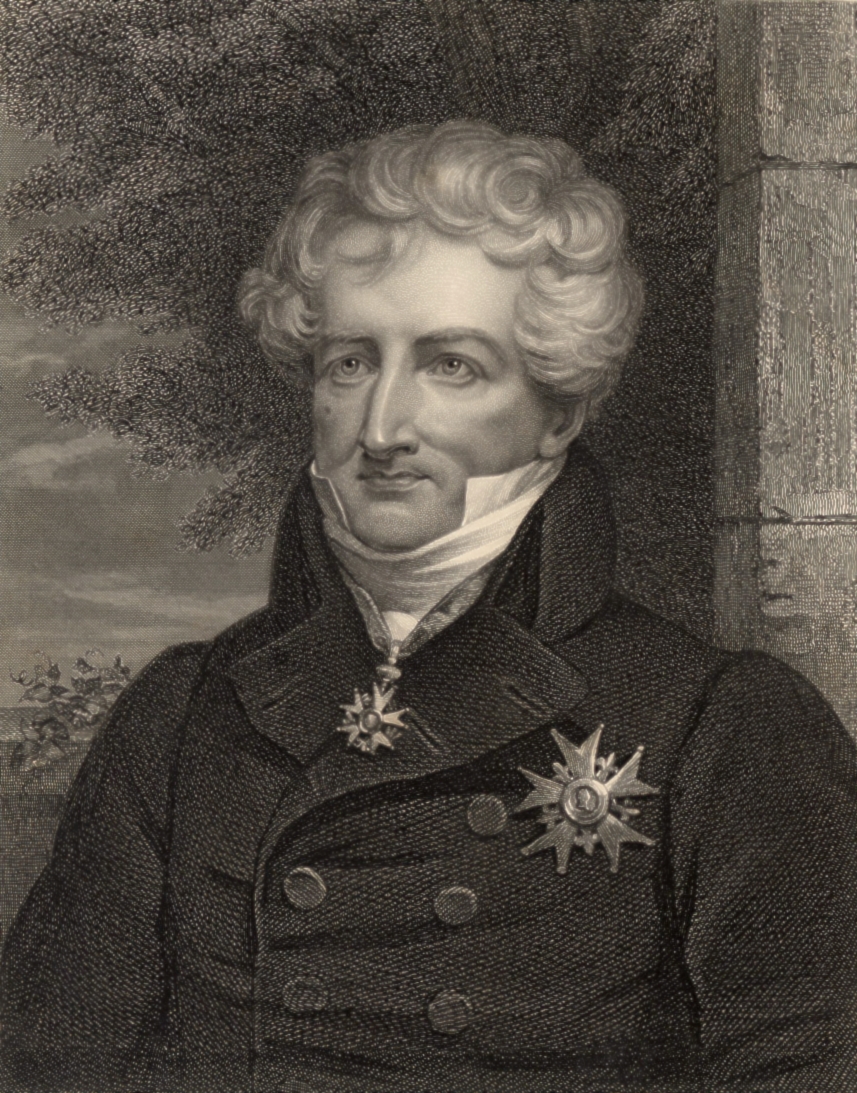 Georges Cuvier Racial studies by Georges Cuvier (1769–1832), the French naturalist and zoologist, influenced both scientific polygenism and scientific racism. Cuvier believed there were three distinct races: the Caucasian (white), Mongolian (yellow), and the Ethiopian (black). He rated each for the beauty or ugliness of the skull and quality of their civilizations. Cuvier wrote about Caucasians: "The white race, with oval face, straight hair and nose, to which the civilised people of Europe belong, and which appear to us the most beautiful of all, is also superior to others by its genius, courage, and activity."[60] Regarding Negroes, Cuvier wrote:[61] The Negro race … is marked by black complexion, crisped or woolly hair, compressed cranium, and a flat nose. The projection of the lower parts of the face, and the thick lips, evidently approximate it to the monkey tribe: the hordes of which it consists have always remained in the most complete state of barbarism. He thought Adam and Eve were Caucasian, and hence, the original race of mankind. The other two races arose by survivors escaping in different directions after a major catastrophe hit the earth approximately 5,000 years ago. Cuvier theorized that the survivors lived in complete isolation from each other, and developed separately as a result.[62][63] One of Cuvier's pupils, Friedrich Tiedemann, was among the first to make a scientific contestation of racism. Tiedemann asserted that based upon his documentation of craniometric and brain measurements of Europeans and black people from different parts of the world, that the then-common European belief that Negroes have smaller brains, and are thus intellectually inferior, was scientifically unfounded, and based merely on the prejudice of travellers and explorers.[64] Arthur Schopenhauer 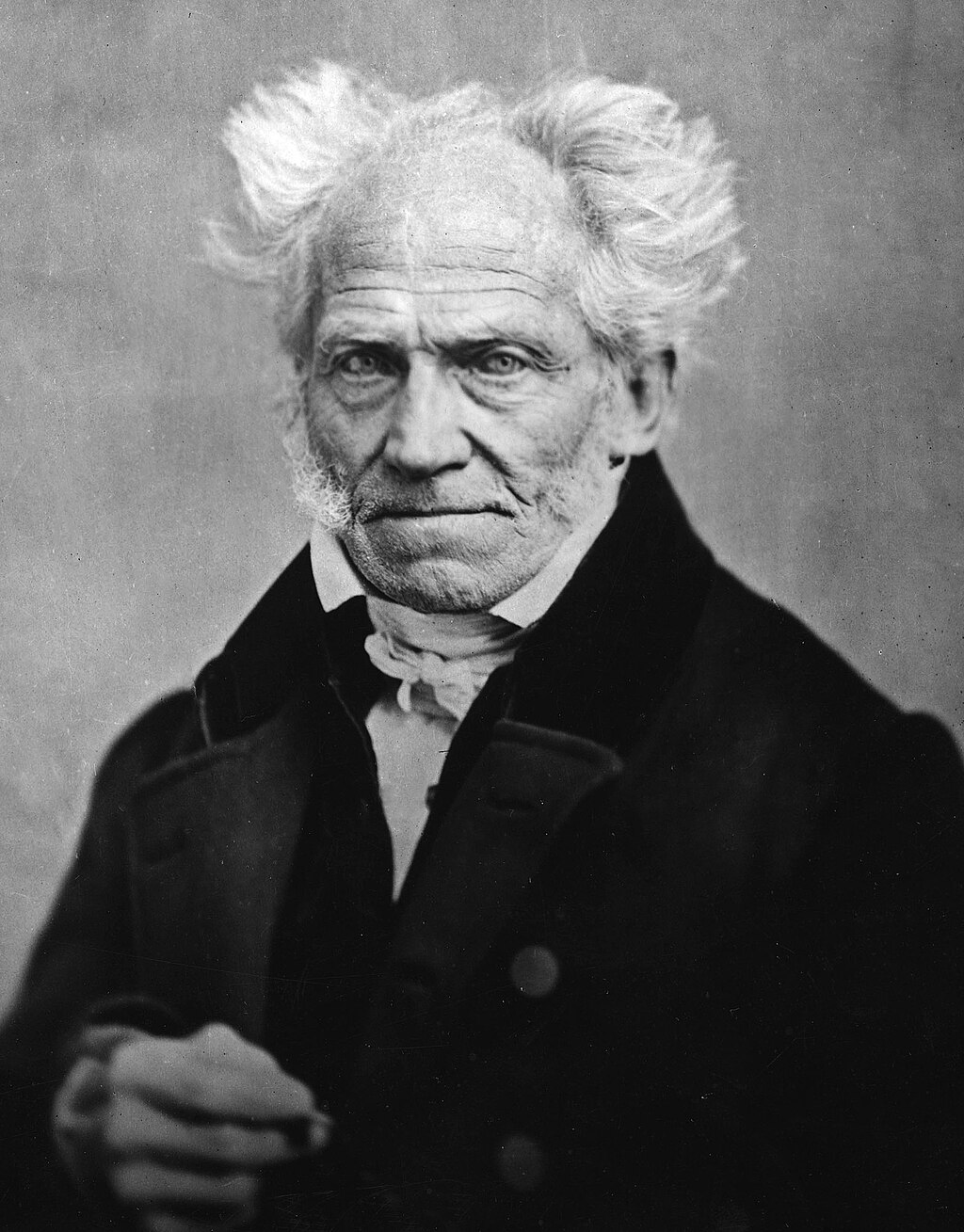 Arthur Schopenhauer The German philosopher Arthur Schopenhauer (1788–1860) attributed civilizational primacy to the white races, who gained sensitivity and intelligence via the refinement caused by living in the rigorous Northern climate:[65] The highest civilization and culture, apart from the ancient Hindus and Egyptians, are found exclusively among the white races; and even with many dark peoples, the ruling caste, or race, is fairer in colour than the rest, and has, therefore, evidently immigrated, for example, the Brahmins, the Inca, and the rulers of the South Sea Islands. All this is due to the fact that necessity is the mother of invention, because those tribes that emigrated early to the north, and there gradually became white, had to develop all their intellectual powers, and invent and perfect all the arts in their struggle with need, want, and misery, which, in their many forms, were brought about by the climate. This they had to do to make up for the parsimony of nature, and out of it all came their high civilization. Franz Ignaz Pruner Franz Ignaz Pruner (1808–1882) was a German physician, ophthalmologist, and anthropologist who studied the racial structure of Negroes in Egypt. In a book Pruner wrote in 1846, he claimed that Negro blood had a negative influence on the Egyptian moral character. He published a monograph on Negroes in 1861. He claimed that the main feature of the Negro's skeleton is prognathism, which he claimed was the Negro's relation to the ape. He also claimed that Negroes had brains very similar to those of apes and that Negroes have a shortened big toe, a characteristic, he said, that connected Negroes closely to apes.[66] |
前身 啓蒙思想家たち 啓蒙時代(1650年代から1780年代にかけての時代)には、一元論と多元論の概念が広まったが、認識論的に体系化されたのは19世紀に入ってからであ る。一元論とは、すべての人種の起源は単一であるとする考え方であり、多元論とは、それぞれの人種の起源は別個であるとする考え方である。18世紀まで は、「人種」と「種」という言葉は互換性があった[16]。 フランソワ・ベルニエ  フランソワ・ベルニエ(1620年-1688年)はフランスの医師であり旅行家であった。1684年、彼は人類を「人種」と呼ぶものに分け、特に女性を肌 の色と他のいくつかの身体的特徴で区別する短いエッセイを発表した。この論文は、ヨーロッパで最も早く出版された学術雑誌である『Journal des Savants』に匿名で掲載され、タイトルは「New Division of the Earth by the Different Species or 'Races' of Man that Inhabit It」であった[17]。 1)第1人種はヨーロッパ、北アフリカ、中東、インド、東南アジア、アメリカ大陸の人々、2)第2人種はサハラ以南のアフリカ人、3)第3人種は東アジア と北東アジア人、4)第4人種はサーメ人である。フランスのサロン文化の産物であるこのエッセイは、さまざまな種類の女性の美に重点を置いていた。ベルニ エは、その斬新な分類が世界各地を旅した個人的な体験に基づいていることを強調した。ベルニエは、本質的な遺伝的差異と環境要因に依存する偶発的差異を区 別した。彼はまた、後者の基準がサブタイプを区別するのに関連する可能性があることを示唆した[18]。彼の人種タイプの生物学的分類は、身体的特徴を超 えようとするものではなく、人間の多様性の程度を説明する上で気候や食生活が果たす役割も認めていた。ベルニエは「人間の種」という概念を人類全体を人種 的に分類するために拡張した最初の人物であったが、彼が考えたいわゆる「人種」間の文化的階層を確立することはなかった。その一方で、彼は白人ヨーロッパ 人を他の「人種」が逸脱する規範として明確に位置づけていた[19][18]。 というのも、彼は温帯ヨーロッパ、アメリカ大陸、インドの人々は、文化的には互いに大きく異なるものの、ほぼ同じ人種集団に属していると考えており、イン ド(彼の主な専門分野)とヨーロッパの文明の違いを気候や制度史を通じて説明していたからである。対照的に、彼はヨーロッパ人とアフリカ人の生物学的な違 いを強調し、北欧の寒冷地に住むサーミ(ラップ)人[19]や喜望峰に住むアフリカ人に対しては非常に否定的な発言をした。例えば、ベルニエは次のように 書いている。彼らは小柄で背が低く、脚が太く、肩幅が広く、首が短く、顔はどう形容していいかわからないが、長く、本当にひどく、熊の顔を思わせる。私は ダンツィヒで2度しか彼らを見たことがないが、私が見た肖像画や多くの人々から聞いた話によれば、彼らは醜い動物である」[20]。ジョーン=ポー・ルビ エスが「近代人種言説」と呼ぶものの出現におけるベルニエのイデオロギーの重要性については議論があり、シープ・シュトゥールマンはこれを近代人種思想の 始まりとみなしているが[19]、ルビエスはベルニエの人間観全体を考慮に入れれば、その重要性は低いと考えている[18]。  ロバート・ボイル ロバート・ボイル 人種を研究した初期の科学者はロバート・ボイル(1627-1691)で、イギリス系アイルランド人の自然哲学者、化学者、物理学者、発明家であった。ボ イルは、今日一元論と呼ばれるもの、つまり、どんなに多様な人種であっても、すべての人種は同じ源から生まれたと信じていた: アダムとイブである。彼は、両親が異なる色のアルビノを産んだという報告された話を研究し、アダムとイブはもともと白人であり、白人は異なる色の人種を産 むことができると結論づけた。ロバート・フックとアイザック・ニュートンの、物理学における光学的分散を介した色と光に関する理論は、ロバート・ボイルに よって多因子発生の言説にも拡張され[16]、おそらくこれらの違いは "精液の印象 "によるものだろうと推測された。しかし、ボイルの著作は、当時、「ヨーロッパ人の目」にとって、美しさは色で測られるのではなく、「身長、体の部分の美 しい対称性、顔の良い特徴」[21]で測られるものであったと述べている。 リチャード・ブラッドリー リチャード・ブラッドリー(1688-1732)はイギリスの博物学者。ブラッドリーは、『自然の営みに関する哲学的説明』(1721年)という著書の中 で、肌の色やその他の身体的特徴から「5種類の人間」が存在すると主張した:ヒゲのあるヨーロッパ白人、ヒゲのないアメリカ白人(アメリカ先住民のこ と)、銅色の肌、小さな目、まっすぐな黒髪の男性、まっすぐな黒髪の黒人、巻き毛の黒人。ブラッドリーの記述は、後にリンネが分類するきっかけになったと 推測されている[23]。 ケイムズ卿  ヘンリー・ホーム、ケイムズ卿 スコットランドの弁護士ヘンリー・ホーム、ケイムズ卿(1696-1782)は多系統主義者であり、神が地球上に異なる人種を別々の地域に創造したと信じ ていた。1734年の著書『人間の歴史に関するスケッチ』(Sketches on the History of Man)の中で、ホームは環境、気候、社会の状態は人種の違いを説明できないと主張した。 カール・リンネ このセクションは特定の視点に偏っている可能性があります。記事を改善するか、トークページで議論してください。(2020年6月)  ジュール・デュモン・デュルヴィル著『南極点への航海とオセアニア』より、ホモ・モンストロサス(パタゴニアの巨人)。 スウェーデンの医師、植物学者、動物学者であるカール・リンネ(1707-1778)は、動植物の二命名法という確立された分類学的基礎を修正し、さらに 人間を異なるサブグループに分類した。Systema Naturae』第12版(1767年)において、彼はヒトの種を5つ[25]の「品種」[26][27]に分類した。それぞれは「文化や場所によって異 なる」以下の人相学的特徴を持っていると説明されていた[28]。 アメリカヌス:赤色、胆汁質、直立、黒色、直毛、太い髪、鼻孔が開いている、顔にそばかすがある、あごにひげがない、頑固、熱心、自由、赤い線で自分を塗 る、習慣に支配される[29]。 ヨーロピアヌス:白色で、血色がよく、筋肉質;黄色がかった長い髪;青い目;穏やかで、鋭敏で、独創的;緊密な法衣で覆われている;習慣に支配されている [30]。 アジア人:黄色、メランコリック、堅物、黒髪、黒い目、厳格、高慢、貪欲、ゆるい衣服に身を包む、信仰に支配される[31]。 アファー(Afer)またはアフリカヌス(Africanus):黒色、痰質、リラックス;黒色の縮れ毛;絹のような肌、平らな鼻、腫れぼったい唇;女性 には細長い陰唇がある;乳腺は乳を豊富に与える;ずる賢く、怠惰、怠慢;油脂を自らに塗る;気まぐれに支配される[32][33][34][35]。 モンストロサス(Monstrosus)は、『自然哲学体系(Systema Naturae)』の初版には登場しなかった神話上の人間である。その亜種には以下が含まれる: 4本足で無口、毛深い」ホモ・フェラリス(野生の人間)、動物飼育されたジュヴニス・ルピナス・ヘッセンシス(ヘッセン狼少年)、ジュヴニス・ハノヴェラ ヌス(ハノヴェリアン少年); Puella campanica(シャンパーニュの野生少女)、俊敏だが気弱なHomo monstrosus(怪物人間)、Patagonian giant(パタゴニアの巨人)、Dwarf of the Alps(アルプスの小人)、Monorchid Khoikhoi(ホッテントット)。Amoenitates academicae (1763)において、リンネは神話的なホモ・アンソロモルファ(擬人化された人間)、またはトログロディテ、サテュロス、ヒュドラ、フェニックスなどの 人型の生物を紹介したが、これらは誤ってシミ型の生物と同定された[36]。 リンネのヒト科分類の根拠については異論がある。一方では、リンネの分類は民族中心主義的であるだけでなく、皮膚の色に基づいているように見えるという厳 しい批判がある。レナート・G・マッツォリーニは、皮膚の色に基づく分類はその核心において白人/黒人の極論であり、リンネの考え方は後の人種差別思想の パラダイムとなったと主張した[37] 。 [38]ケネス・A・R・ケネディ(1976)の意見では、リンネは確かに自文化が優れていると考えていたが、ヒトの品種を分類した動機は人種中心ではな かった。 [39]古生物学者のスティーヴン・ジェイ・グールド(1994)は、分類は「人種差別主義者の伝統の中でほとんどのヨーロッパ人が好んでいたランク付け された順序ではなかった」と主張し、リンネの分類は人の気質は生物学的な体液と関係があるかもしれないという医学的な体液理論に影響を受けたと述べた。 [40][41]1994年のエッセイでグールドは次のように付け加えた。「私は、リンネが自分のヨーロッパ品種が他の品種よりも優れているという従来の 信念を持っていたことを否定するつもりはない...それにもかかわらず、そしてこのような含意にもかかわらず、リンネのモデルのあからさまな幾何学は直線 的でも階層的でもない」[42]。 2008年にロンドンのリンネ学会から発表されたエッセイの中で、マリー=クリスティン・スクンクはリンネの発言を「ヨーロッパ人の優位性は "文化 "にあり、リンネの分類群における決定的な要因は人種ではなく "文化 "である」という見解を反映していると解釈している。したがって、このトピックに関して、スクンクはリンネウスの見解を単なる「ヨーロッパ中心主義」であ るとみなしており、リンネウスは人種差別的な行動を呼びかけたことはなく、「人種」という言葉も使わなかったと主張している。 しかし、人類学者のアシュレイ・モンタグは、その著書『人間の最も危険な神話:人種の誤謬』の中で、ビュフォンはまさに「あらゆる厳格な分類の敵」 [44]であり、そのような大雑把な分類に正反対であり、それらを説明するために「人種」という言葉を使わなかったと指摘している。「ビュフォンがこの言 葉を狭義の意味ではなく、むしろ一般的な意味で使っていることは、ビュフォンを読めば明らかだった」[44]とモンタグは書いている: 例えば、「デンマーク人、スウェーデン人、ムスコビトのラップランド人、ノヴァ・ゼンブラの住民、ボランディア人、サモイデス人、旧大陸のオスティアック 人、グリーンランド人、そして新大陸のエスキモー・インディアンの北側の未開人は、一つの共通の人種であるように見える」[45]。 学者のスタンリーA.ライスは、リンネの分類が「人間性や優劣のヒエラルキーを意味する」ものではなかったことに同意している[46]が、現代の批評家た ちは、リンネの分類は明らかにステレオタイプであり、風習や伝統のような人類学的、非生物学的特徴を含んでいる点で誤りであるとみなしている。 ジョン・ハンター  ジョン・ハンター 1786年にロイヤル・アカデミーに出品したジョシュア・レイノルズ卿の原画をもとに、1813年にジョン・ジャクソンが描いた。 スコットランドの外科医ジョン・ハンター(1728-1793)は、ネグロイド人種は生まれながらにして白人であると考えた。彼は、時間の経過とともに、 太陽のせいで、人々は黒い肌、つまり "黒 "になったと考えた。ハンターはまた、黒人の水ぶくれや火傷は白くなる可能性が高いと述べ、それが彼らの祖先が元々白人であった証拠であると主張した [47]。 チャールズ・ホワイト  チャールズ・ホワイト(1728年-1813年)はイギリスの医師であり外科医であったが、人種は「存在の大いなる連鎖」の中で異なる位置を占めていると 考え、人類の人種が互いに異なる起源を持っていることを科学的に証明しようとした。彼は白人と黒人は2つの異なる種であると推測した。ホワイトは、異なる 人種は別々に創られたという考えである多系統性を信奉していた。彼の『Account of the Regular Gradation in Man』(1799年)は、この考えに実証的な根拠を与えた。ホワイトは、フランスの博物学者ジョルジュ=ルイ・ルクレール(ビュフォン伯爵)の「同じ種 同士しか交配できない」という交配性論に反論することで、多系統説を擁護した。ホワイトは、キツネ、オオカミ、ジャッカルといった種の交雑を指摘した。ホ ワイトにとって、それぞれの種族は独立した種であり、それぞれの地理的地域のために神が創造したものであった[24]。 ビュフォンとブルーメンバッハ  ヨハン・フリードリヒ・ブルメンバッハ フランスの博物学者ジョルジュ=ルイ・ルクレール(Georges-Louis Leclerc, Comte de Buffon, 1707-1788)とドイツの解剖学者ヨハン・ブルメンバッハ(Johann Blumenbach, 1752-1840)は、すべての人種は単一の起源を持つという概念である一元論の支持者であった。 [このモデルによれば、ネグロイドの色素沈着は熱帯の太陽の熱のために生じ、エスキモーの褐色は寒風のためであり、中国人の肌はタルタル人よりも白かっ た。 [48]興味深いことに、ビュフォンとブルーメンバッハはともに、適切な環境制御がなされれば退化は逆転し、現代人のすべての形態は元の白人種に戻ること ができると信じていた[48]。 ブルーメンバッハによれば、5つの人種が存在し、すべてが単一の種に属している: 白人、モンゴル人、ネグロイド、アメリカ人、マレー人である。ブルーメンバッハはこう述べている: 「私がコーカソイドを第一の種族としたのは、以下に述べる理由からである。(→「 ヨハン・フリードリヒ・ブルメンバッハ」が人種主義者であったかどうかは、議論の余地がある) ジェームズ・ハットンと科学的な地質学が出現する以前は、多くの人々が地球は6,000年しか経っていないと信じていた。ビュフォンは熱した鉄球を使った 実験を行い、それが地球の核のモデルであると考え、地球は75,000歳であると結論づけたが、アダムと人類の起源からの時間を8,000年以上遡ること はなかった。 ベンジャミン・ラッシュ アメリカ建国の父であり医師であったベンジャミン・ラッシュ(1745年-1813年)は、黒人であることは遺伝性の皮膚病であり、彼はそれを「ネグロイ ド症」と呼び、治すことができると提唱した。ラッシュは、非白人は実は肌の色は白いが、伝染性のないハンセン病にかかっており、そのために肌の色が黒く なっていると考えた。ラッシュは、「白人は(黒人を)横暴に扱うべきではない、彼らの病気は彼らに人間性の二倍の部分を与える権利があるはずだからだ」と いう結論を導き出した。しかし、同じ意味で、白人は彼らと結婚すべきではない。なぜなら、それは後世の人々に『障害』を感染させることになるからである。 クリストフ・マイナース  クリストフ・マイナース(1747-1810)はドイツの多遺伝子論者で、それぞれの人種には別々の起源があると信じていた。マイナースは各人種の身体 的、精神的、道徳的特徴を研究し、その結果に基づいて人種階層を構築した。彼は人類を「美しい白色人種」と「醜い黒色人種」の2つに分けた。マイナースは 『人類史概説』という著書の中で、人種の主な特徴は美醜のどちらかであると主張した。マイナースは白人種だけを美しいと考え、醜い人種は劣等で、不道徳 で、動物のようだと考えた。マイナースは、暗くて醜い民族が、美徳の「悲しい」欠如と「恐ろしい悪徳」によって、白くて美しい民族とどのように区別される のかについて書いている[51]。 マインズは、黒人が他のどの人種よりも痛みを感じず、感情が欠如しているという仮説を立てた。マインズは、黒人は神経が太く、他の人種のように敏感ではな いと書いている。彼は、黒人は "人間的な感情もなければ、動物的な感情もない "とまで言った。マインズは、ある黒人が生きたまま火刑に処せられた話を紹介した。火刑の途中で、その黒人はパイプを吸いたいと言い出し、何事もなかった かのようにパイプを吸いながら、生きたまま火刑に処され続けた。マインズは黒人の解剖学を研究し、黒人は他のどの人種よりも歯と顎が大きいという観察結果 から、黒人はすべて肉食であるという結論に達した。マインズは、黒人の頭蓋骨は他のどの人種よりも大きいが、脳は他のどの人種よりも小さいと主張した。マ インズは、黒人はその貧しい食生活、生活様式、モラルの欠如のために、地球上で最も不健康な人種であると理論化した[52]。 マインズはアメリカ人の食生活を研究し、彼らはあらゆる「汚い臓物」を食べ、大量のアルコールを摂取していると述べた。彼は彼らの頭蓋骨は非常に厚く、ス ペイン剣の刃がその上で砕け散ると信じていた。マインズはまた、アメリカ人の皮膚は牛の皮膚よりも厚いと主張した[52]。 マイナースは最も高貴な民族はケルト人であると書いた。これは、彼らが世界各地を征服することができたこと、暑さや寒さに敏感であること、そして彼らの繊 細さは食べるものを選別することで示されているという主張に基づいている。マイナーは、スラブ人は劣った人種であり、"繊細さに欠け、粗食で満足する "と主張した。彼は、スラブ人が毒キノコを食べても害がなかったとされる話を紹介した。彼はスラヴ人の医療技術も逆効果であると主張し、その例として、病 人をオーブンで温め、雪の中で転ばせるという習慣について述べた[52]。 後の思想家 トーマス・ジェファーソン トーマス・ジェファーソン(1743-1826)はアメリカの政治家、科学者[53][54]、奴隷所有者であった。科学的人種差別に対する彼の貢献は、 多くの歴史家、科学者、学者によって指摘されている。McGill Journal of Medicine』誌に掲載された論文によれば、次の通りである: ダーウィン以前の人種理論家の中で最も影響力のある一人であるジェファーソンは、アフリカ系アメリカ人の明らかな "劣等性 "を決定するために科学を呼びかけた。 55]『ニューヨーク・タイムズ』紙に寄稿した歴史家ポール・フィンケルマンは、「科学者であったジェファーソンは、それにもかかわらず、黒人は『血の色 に由来する』のではないかと推測し、黒人は『肉体と精神の素質において白人より劣っている』と結論づけた」と述べている[56]。 彼らは睡眠をあまり必要としないようだ。黒人は一日中重労働をした後、わずかな娯楽に誘われて、夜中まで、あるいはもっと遅くまで起きている。彼らは少な くとも勇敢で、冒険好きなのだ。しかし、これはおそらく、危険が目の前に迫ってくるまで危険を察知することができない、先見の明のなさからくるものだろ う。危険な目に遭っても、白人ほど冷静かつ堅実にやり過ごすことはない。彼らは女性をより熱烈に求めるが、愛とは、情緒と感覚の柔らかな繊細な混合という よりは、熱烈な欲望であるように思われる。彼らの悲しみは一過性のものである。天がわれわれに生命を与えたのが慈悲によるものか怒りによるものかを疑わせ るような無数の苦難は、彼らにはあまり感じられず、すぐに忘れ去られる。一般に、その存在は、内省よりも感覚的なものであるように見える...。記憶力、 理性、想像力といった能力で比較すると、記憶力においては白人と同等であり、理性においてははるかに劣っている。したがって、私は、黒人がもともと別個の 人種であったにせよ、時代と状況によって別個の人種となったにせよ、心身ともに白人より劣っているのではないかという疑念を抱いているにすぎない。 しかし1791年、ジェファーソンは、教養ある黒人数学者ベンジャミン・バネカーから手紙と年鑑を贈られ、黒人に知性があるかどうかという以前の疑念を見 直さざるを得なくなった。黒人の知性の存在について科学的な証拠を発見したことを喜んだジェファーソンは、バネカーに次のように手紙を書いた[58]。 自然が黒人の同胞に、他の有色人種と同等の才能を与えていること、そしてそのような才能が欠けているように見えるのは、アフリカとアメリカの両方における 彼らの存在が単に劣悪な状態にあるためであること。私は、彼らの肉体と精神の両方の状態を、現在の存在の無能さと、無視できないその他の状況が許す限り、 あるべき姿に早急に引き上げるための優れたシステムが開始されることを、これほど切に望む者はいないことを、真実をもって付け加えることができる。 サミュエル・スタンホープ・スミス サミュエル・スタンホープ・スミス(1751-1819)はアメリカの長老派の牧師で、『Essay on the Causes of Variety of Complexion and Figure in the Human Species』(1787)の著者である。スミスは、黒人の色素沈着は熱帯気候によって引き起こされた胆汁の過剰供給の結果として全身を覆う巨大なそば かすに過ぎないと主張した[59]。 ジョルジュ・キュヴィエ  ジョルジュ・キュヴィエ フランスの博物学者であり動物学者であったジョルジュ・キュヴィエ(1769-1832)による人種研究は、科学的多元論と科学的人種主義の両方に影響を 与えた。キュヴィエは、コーカソイド(白人)、モンゴル人(黄色人種)、エチオピア人(黒人)の3つの人種が存在すると考えた。彼はそれぞれを頭蓋骨の美 しさや醜さ、文明の質で評価した。キュヴィエは白人についてこう書いている: 「楕円形の顔、まっすぐな髪と鼻を持つ白人種は、ヨーロッパの文明人が属しており、われわれにはすべての中で最も美しく見えるが、天才、勇気、活動性にお いても他の人種より優れている」[60]。 黒人についてキュヴィエは次のように書いている[61]。 黒人は......黒い顔色、ぱさぱさした毛髪、圧縮された頭蓋、平らな鼻が特徴である。顔の下部の突起と厚い唇は、明らかにサル族に似ている。 アダムとイブはコーカサス人であり、それゆえ人類の原種であると彼は考えた。他の2つの人種は、約5000年前に大災害が地球を襲った後、生存者がさまざ まな方向に逃れたことで生まれた。キュヴィエは、生存者たちは互いに完全に隔離された状態で生活し、その結果別々に発展したと理論化した[62] [63]。 キュヴィエの弟子の一人であるフリードリッヒ・ティーデマンは、人種差別を科学的に論じた最初の人物の一人であった。ティーデマンは、世界各地のヨーロッ パ人と黒人の頭蓋計測と脳計測の記録に基づいて、当時ヨーロッパで一般的であった黒人は脳が小さく、そのため知的に劣っているという考えは科学的に根拠が なく、単に旅行者や探検家の偏見に基づいていると主張した[64]。 アーサー・ショーペンハウアー  アーサー・ショーペンハウアー ドイツの哲学者であるアルトゥール・ショーペンハウアー(1788-1860)は、文明の優越性を白色人種に帰結させ、白色人種は北方の厳しい気候の中で 生活することによって洗練された感性と知性を得たとした[65]。 古代ヒンズー教徒とエジプト人を除けば、最高の文明と文化は白色人種にのみ見られる。多くの暗黒民族でさえ、支配者カースト(人種)は他の民族よりも色が 白く、したがって、例えばバラモン人、インカ人、南洋諸島の支配者のように、明らかに移民してきた。というのも、早くから北部に移住し、そこで次第に白人 となった部族は、あらゆる知的能力を発達させ、あらゆる芸術を発明し、完成させなければならなかったからである。このような自然の乏しさを補うために、彼 らはあらゆる知恵を絞り、あらゆる芸術を発明し、完成させなければならなかった。 フランツ・イグナーツ・プルナー フランツ・イグナーツ・プルナー(1808-1882)は、ドイツの医師、眼科医、人類学者で、エジプトにおける黒人の人種構造を研究した。1846年に 執筆した本の中で、彼は黒人の血がエジプト人の道徳的性格に悪影響を及ぼしていると主張した。彼は1861年に黒人に関する単行本を出版した。彼は、黒人 の骨格の主な特徴は前突症であり、これは黒人と猿との関係であると主張した。彼はまた、黒人は類人猿と非常によく似た脳を持っていると主張し、黒人は短く なった外反母趾を持っており、これは黒人と類人猿を密接に結びつける特徴であると述べた[66]。 |
Racial theories in physical
anthropology (1850–1918) A late-19th-century illustration by H. Strickland Constable shows an alleged similarity between "Irish Iberian" and "Negro" features in contrast to the higher "Anglo-Teutonic". The scientific classification established by Carl Linnaeus is requisite to any human racial classification scheme. In the 19th century, unilineal evolution, or classical social evolution, was a conflation of competing sociologic and anthropologic theories proposing that Western European culture was the acme of human socio-cultural evolution. The Christian Bible was interpreted to sanction slavery and from the 1820s to the 1850s was often used in the antebellum Southern United States, by writers such as the Rev. Richard Furman and Thomas R. Cobb, to enforce the idea that Negroes had been created inferior, and thus suited to slavery.[67] Arthur de Gobineau 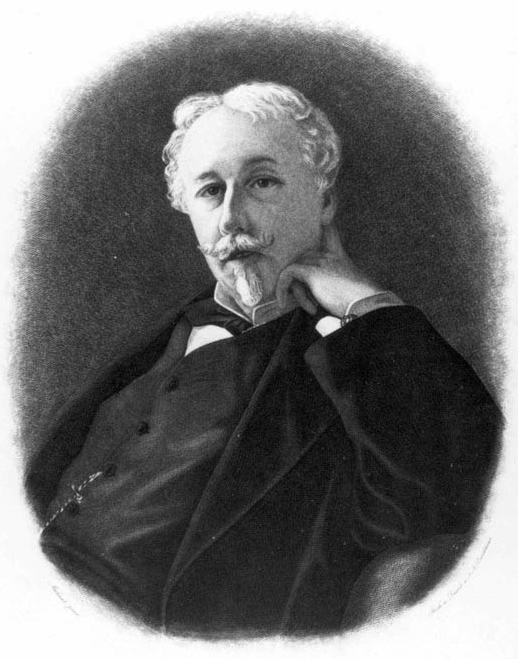 Portrait of Arthur de Gobineau by the Comtesse de la Tour, 1876 The French aristocrat and writer Arthur de Gobineau (1816–1882), is best known for his book An Essay on the Inequality of the Human Races (1853–55) which proposed three human races (black, white and yellow) were natural barriers and claimed that race mixing would lead to the collapse of culture and civilization. He claimed that "The white race originally possessed the monopoly of beauty, intelligence and strength" and that any positive accomplishments or thinking of blacks and Asians were due to an admixture with whites. His works were praised by many white supremacist American pro-slavery thinkers such as Josiah C. Nott and Henry Hotze. Gobineau believed that the different races originated in different areas, the white race had originated somewhere in Siberia, the Asians in the Americas and the blacks in Africa. He believed that the white race was superior, writing: I will not wait for the friends of equality to show me such and such passages in books written by missionaries or sea captains, who declare some Wolof is a fine carpenter, some Hottentot a good servant, that a Kaffir dances and plays the violin, that some Bambara knows arithmetic… Let us leave aside these puerilities and compare together not men, but groups.[68] Gobineau later used the term "Aryans" to describe the Germanic peoples (la race germanique).[69] Gobineau's works were also influential to the Nazi Party, which published his works in German. They played a key role in the master race theory of Nazism. Carl Vogt 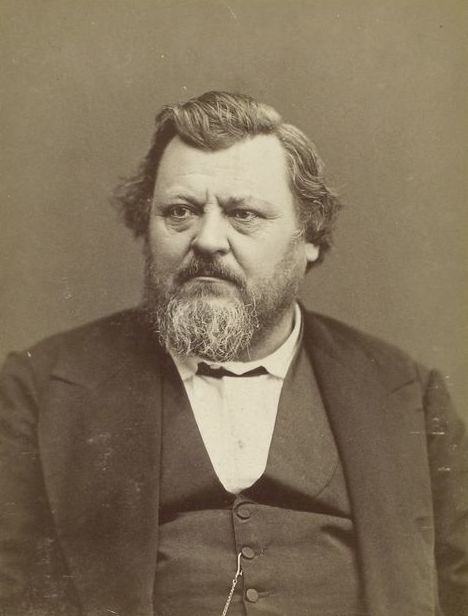 Carl Vogt in 1870 Another polygenist evolutionist was Carl Vogt (1817–1895) who believed that the Negro race was related to the ape. He wrote the white race was a separate species to Negroes. In Chapter VII of his Lectures of Man (1864) he compared the Negro to the white race whom he described as "two extreme human types". The difference between them, he claimed are greater than those between two species of ape; and this proves that Negroes are a separate species from the whites.[70] Charles Darwin 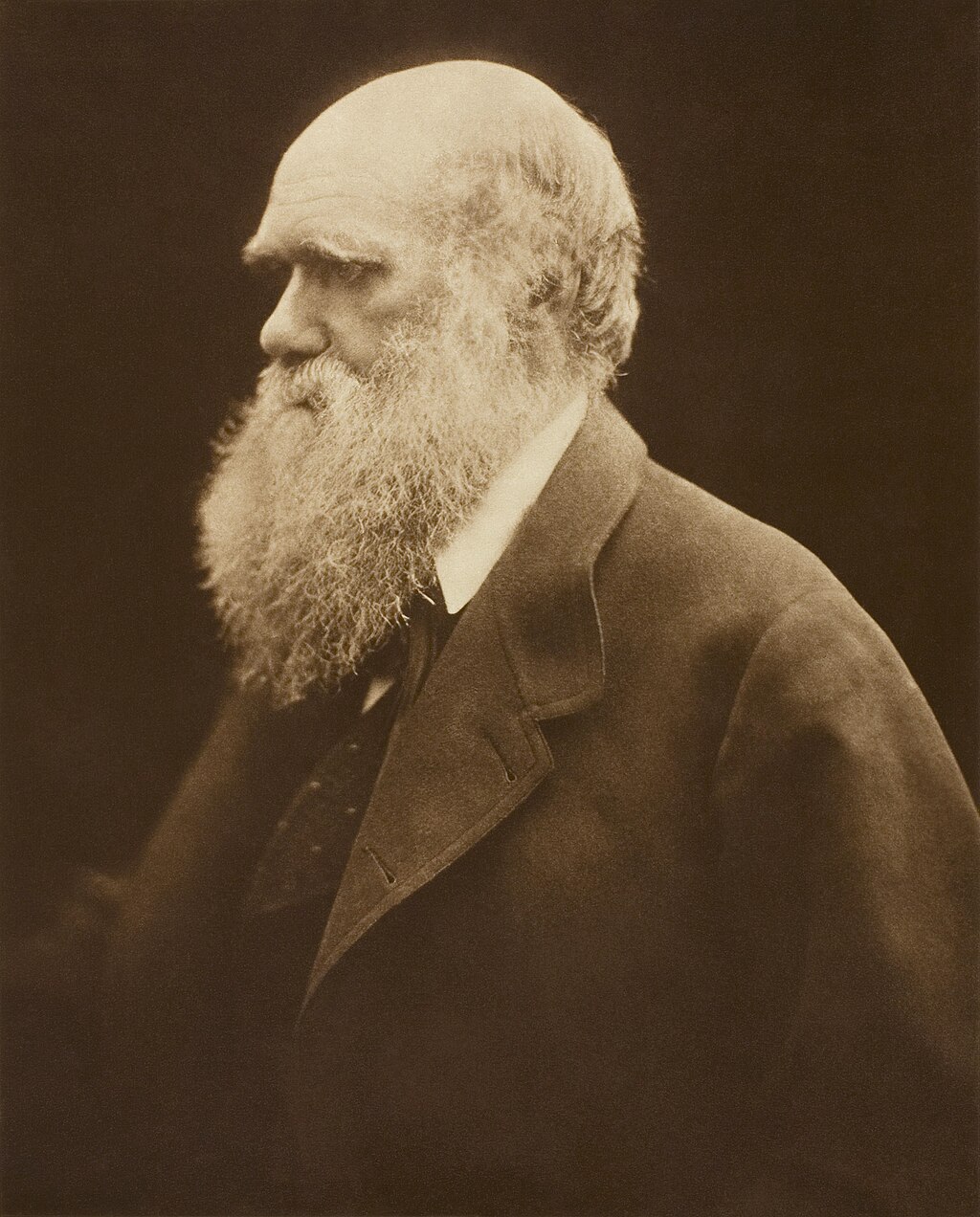 Charles Darwin in 1868 Charles Darwin's views on race have been a topic of much discussion and debate. According to Jackson and Weidman, Darwin was a moderate in the 19th century debates about race. "He was not a confirmed racist — he was a staunch abolitionist, for example — but he did think that there were distinct races that could be ranked in a hierarchy."[71] Darwin's influential 1859 book On the Origin of Species did not discuss human origins. The extended wording on the title page, which adds by Means of Natural Selection, or the Preservation of Favoured Races in the Struggle for Life, uses the general terminology of biological races as an alternative for "varieties" such as "the several races, for instance, of the cabbage", and does not carry the modern connotation of human races. In The Descent of Man, and Selection in Relation to Sex (1871), Darwin examined the question of "Arguments in favour of, and opposed to, ranking the so-called races of man as distinct species" and reported no racial distinctions that would indicate that human races are discrete species.[67][72] The historian Richard Hofstadter wrote: Although Darwinism was not the primary source of the belligerent ideology and dogmatic racism of the late nineteenth century, it did become a new instrument in the hands of the theorists of race and struggle... The Darwinist mood sustained the belief in Anglo-Saxon racial superiority which obsessed many American thinkers in the latter half of the nineteenth century. The measure of world domination already achieved by the 'race' seemed to prove it the fittest.[73] According to the historian Gertrude Himmelfarb, "The subtitle of [The Origin of Species] made a convenient motto for racists: 'The Preservation of Favoured Races in the Struggle for Life.' Darwin, of course, took 'races' to mean varieties or species; but it was no violation of his meaning to extend it to human races.... Darwin himself, in spite of his aversion to slavery, was not averse to the idea that some races were more fit than others."[74] On the other hand, Robert Bannister defended Darwin on the issue of race, writing that "Upon closer inspection, the case against Darwin himself quickly unravels. An ardent opponent of slavery, he consistently opposed the oppression of nonwhites... Although by modern standards The Descent of Man is frustratingly inconclusive on the critical issues of human equality, it was a model of moderation and scientific caution in the context of midcentury racism."[75] Herbert Hope Risley 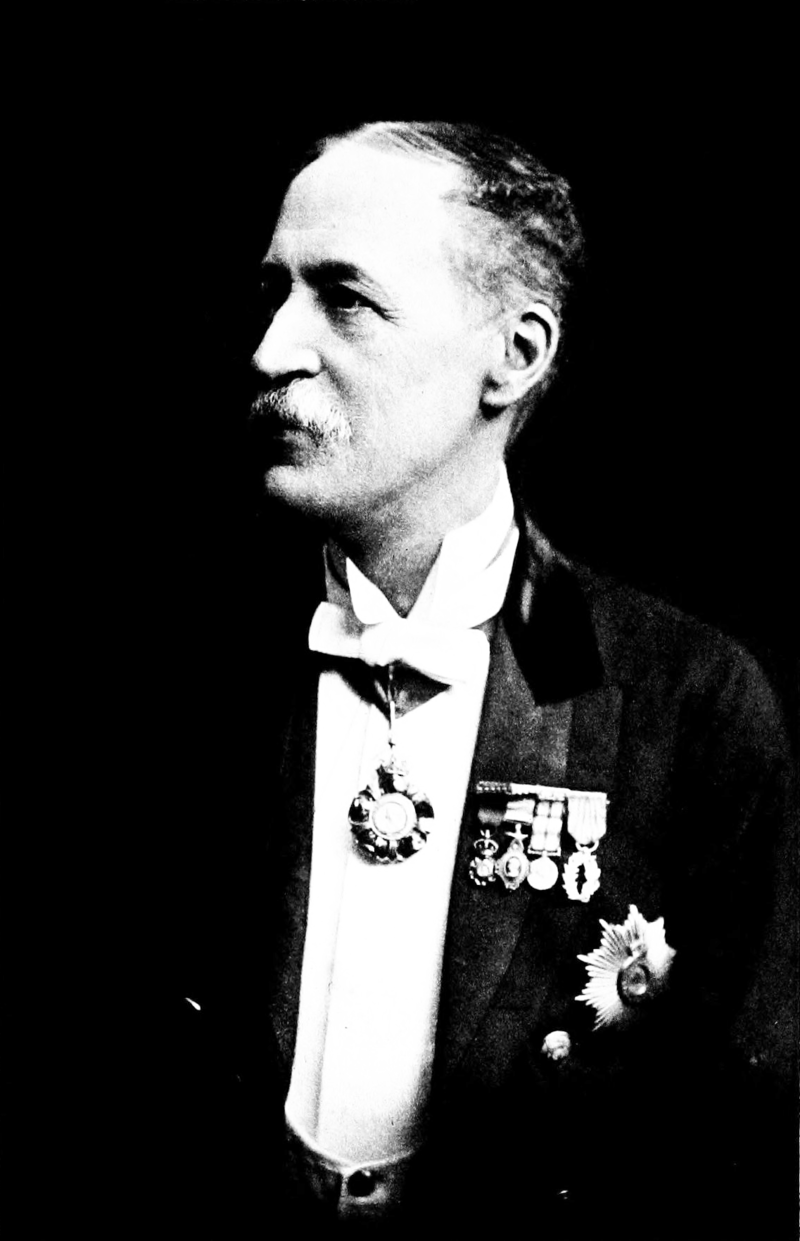 Herbert Hope Risley As an exponent of "race science", colonial administrator Herbert Hope Risley (1851–1911) used the ratio of the width of a nose to its height to divide Indian people into Aryan and Dravidian races, as well as seven castes.[76][77] Ernst Haeckel 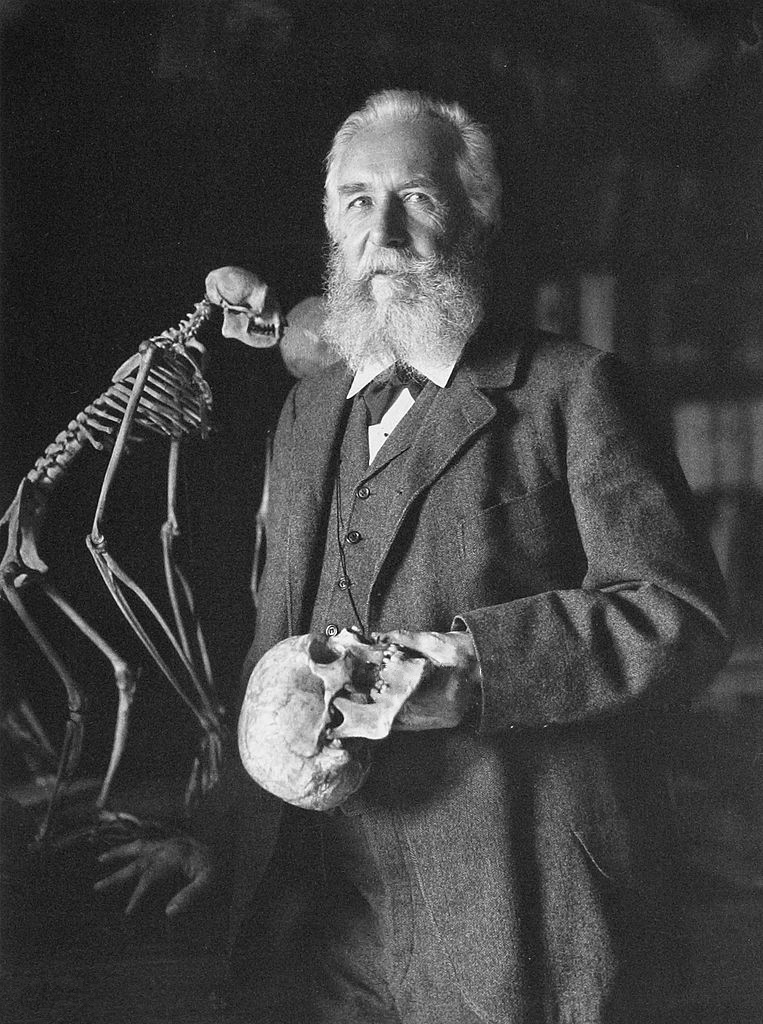 Ernst Haeckel Like most of Darwin's supporters,[citation needed] Ernst Haeckel (1834–1919) put forward a doctrine of evolutionary polygenism based on the ideas of the linguist and polygenist August Schleicher, in which several different language groups had arisen separately from speechless prehuman Urmenschen (German for 'original humans'), which themselves had evolved from simian ancestors. These separate languages had completed the transition from animals to man, and, under the influence of each main branch of languages, humans had evolved as separate species, which could be subdivided into races. Haeckel divided human beings into ten races, of which the Caucasian was the highest and the primitives were doomed to extinction.[78] Haeckel was also an advocate of the out of Asia theory by writing that the origin of humanity was to be found in Asia; he believed that Hindustan (South Asia) was the actual location where the first humans had evolved. Haeckel argued that humans were closely related to the primates of Southeast Asia and rejected Darwin's hypothesis of Africa.[79][80] Haeckel also wrote that Negroes have stronger and more freely movable toes than any other race which is evidence that Negroes are related to apes because when apes stop climbing in trees they hold on to the trees with their toes. Haeckel compared Negroes to "four-handed" apes. Haeckel also believed Negroes were savages and that whites were the most civilised.[70] Nationalism of Lapouge and Herder At the 19th century's end, scientific racism conflated Greco-Roman eugenicism with Francis Galton's concept of voluntary eugenics to produce a form of coercive, anti-immigrant government programs influenced by other socio-political discourses and events. Such institutional racism was effected via phrenology, telling character from physiognomy; craniometric skull and skeleton studies; thus skulls and skeletons of black people and other colored volk, were displayed between apes and white men. In 1906, Ota Benga, a Pygmy, was displayed as the "Missing Link", in the Bronx Zoo, New York City, alongside apes and animals. The most influential theorists included the anthropologist Georges Vacher de Lapouge (1854–1936) who proposed "anthroposociology"; and Johann Gottfried Herder (1744–1803), who applied "race" to nationalist theory, thereby developing the first conception of ethnic nationalism. In 1882, Ernest Renan contradicted Herder with a nationalism based upon the "will to live together", not founded upon ethnic or racial prerequisites (see Civic nationalism). Scientific racist discourse posited the historical existence of "national races" such as the Deutsche Volk in Germany, and the "French race" being a branch of the basal "Aryan race" extant for millennia, to advocate for geopolitical borders parallel to the racial ones. Craniometry and physical anthropology Further information: Craniometry and physical anthropology 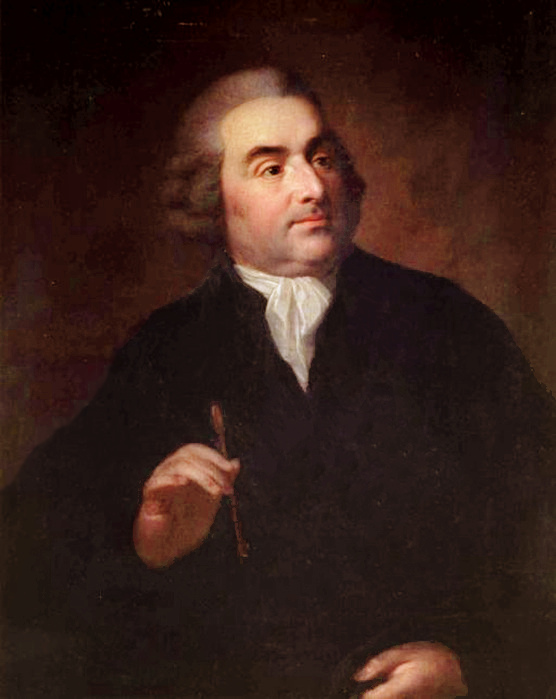 Pieter Camper The Dutch scholar Pieter Camper (1722–89), an early craniometric theoretician, used "craniometry" (interior skull-volume measurement) to scientifically justify racial differences. In 1770, he conceived of the facial angle to measure intelligence among species of men. The facial angle was formed by drawing two lines: a horizontal line from nostril to ear; and a vertical line from the upper-jawbone prominence to the forehead prominence. Camper's craniometry reported that antique statues (the Greco-Roman ideal) had a 90-degree facial angle, whites an 80-degree angle, blacks a 70-degree angle, and the orangutan a 58-degree facial angle—thus he established a racist biological hierarchy for mankind, per the Decadent conception of history. Such scientific racist researches were continued by the naturalist Étienne Geoffroy Saint-Hilaire (1772–1844) and the anthropologist Paul Broca (1824–1880). Samuel George Morton  Racialist differences: "a Negro head ... a Caucasian skull ... a Mongol head", Samuel George Morton, 1839 In the 19th century, an early American physical anthropologist, physician and polygenist Samuel George Morton (1799–1851), collected human skulls from worldwide, and attempted a logical classification scheme. Influenced by contemporary racialist theory, Dr Morton said he could judge racial intellectual capacity by measuring the interior cranial capacity, hence a large skull denoted a large brain, thus high intellectual capacity. Conversely, a small skull denoted a small brain, thus low intellectual capacity; superior and inferior established. After inspecting three mummies from ancient Egyptian catacombs, Morton concluded that Caucasians and Negroes were already distinct three thousand years ago. Since interpretations of the bible indicated that Noah's Ark had washed up on Mount Ararat only a thousand years earlier, Morton claimed that Noah's sons could not possibly account for every race on earth. According to Morton's theory of polygenesis, races have been separate since the start.[81] In Morton's Crania Americana, his claims were based on craniometry data, that the Caucasians had the biggest brains, averaging 87 cubic inches, Native Americans were in the middle with an average of 82 cubic inches and Negroes had the smallest brains with an average of 78 cubic inches.[81] 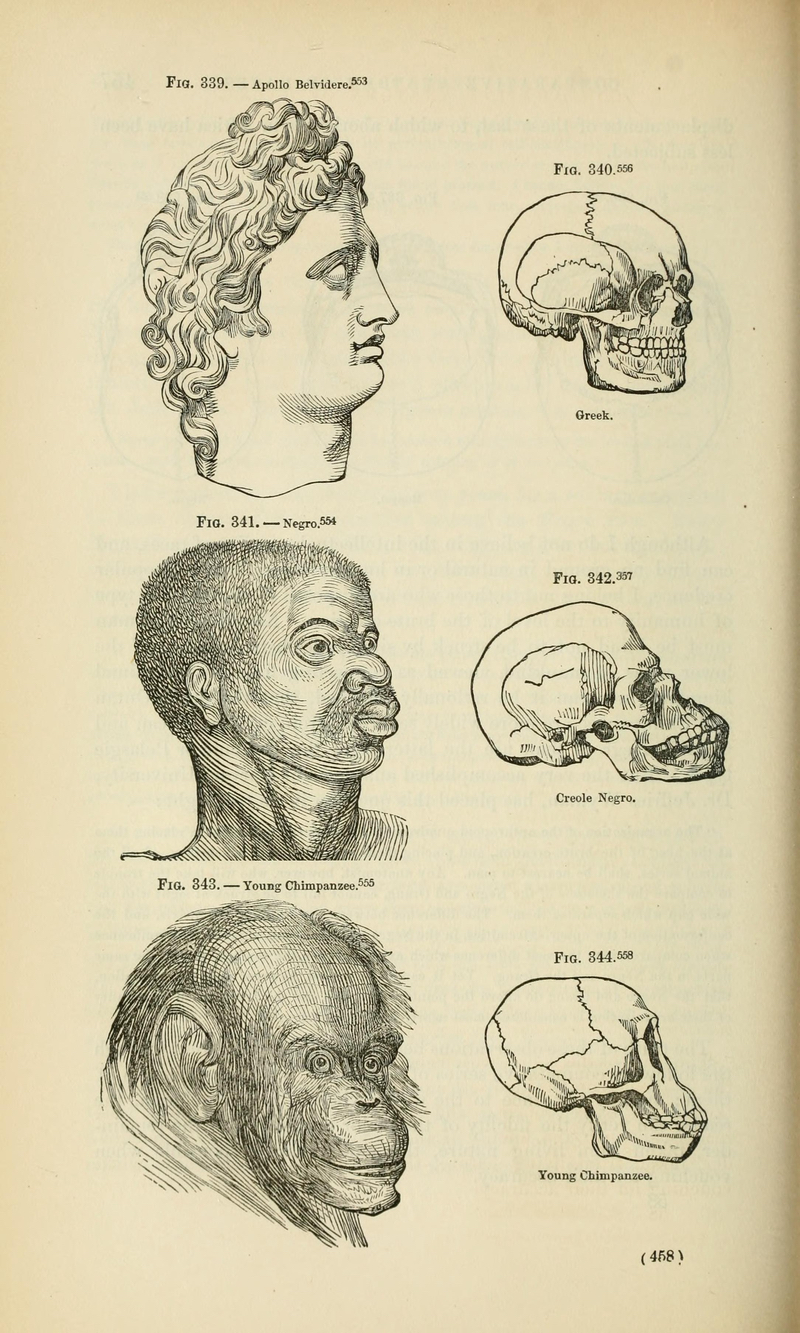 Illustration from Types of Mankind (1854), whose authors Josiah Clark Nott and George Robins Gliddon implied that "Negroes" were a creational rank between "Greeks" and chimpanzees. In The Mismeasure of Man (1981), the evolutionary biologist and historian of science Stephen Jay Gould argued that Samuel Morton had falsified the craniometric data, perhaps inadvertently over-packing some skulls, to so produce results that would legitimize the racist presumptions he was attempting to prove. A subsequent study by the anthropologist John Michael found Morton's original data to be more accurate than Gould describes, concluding that "[c]ontrary to Gould's interpretation... Morton's research was conducted with integrity".[82] Jason Lewis and colleagues reached similar conclusions as Michael in their reanalysis of Morton's skull collection; however, they depart from Morton's racist conclusions by adding that "studies have demonstrated that modern human variation is generally continuous, rather than discrete or "racial", and that most variation in modern humans is within, rather than between, populations".[83] In 1873, Paul Broca, founder of the Anthropological Society of Paris (1859), found the same pattern of measures—that Crania Americana reported—by weighing specimen brains at autopsy. Other historical studies, proposing a black race–white race, intelligence–brain size difference, include those by Bean (1906), Mall (1909), Pearl (1934), and Vint (1934). Nicolás Palacios After the War of the Pacific (1879–83) there was a rise of racial and national superiority ideas among the Chilean ruling class.[84] In his 1918 book physician Nicolás Palacios argued for the existence of Chilean race and its superiority when compared to neighboring peoples. He thought Chileans were a mix of two martial races: the indigenous Mapuches and the Visigoths of Spain, who descended ultimately from Götaland in Sweden. Palacios argued on medical grounds against immigration to Chile from southern Europe claiming that Mestizos who are of south European stock lack "cerebral control" and are a social burden.[85] Monogenism and polygenism Further information: Monogenism and Polygenism Samuel Morton's followers, especially Dr Josiah C. Nott (1804–1873) and George Gliddon (1809–1857), extended Dr Morton's ideas in Types of Mankind (1854), claiming that Morton's findings supported the notion of polygenism (mankind has discrete genetic ancestries; the races are evolutionarily unrelated), which is a predecessor of the modern human multiregional origin hypothesis. Moreover, Morton himself had been reluctant to espouse polygenism, because it theologically challenged the Christian creation myth espoused in the Bible. Later, in The Descent of Man (1871), Charles Darwin proposed the single-origin hypothesis, i.e., monogenism—mankind has a common genetic ancestry, the races are related, opposing everything that the polygenism of Nott and Gliddon proposed. Typologies 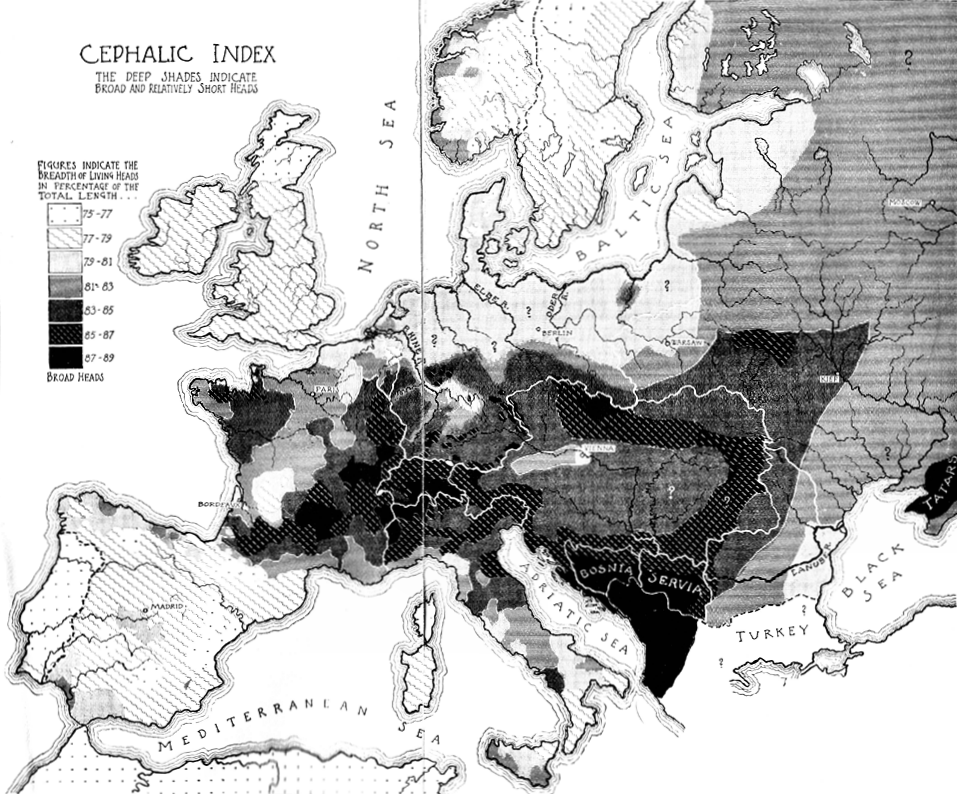 Cephalic Index. William Z. Ripley's European cephalic index map, The Races of Europe (1899). One of the first typologies used to classify various human races was invented by Georges Vacher de Lapouge (1854–1936), a theoretician of eugenics, who published in 1899 L'Aryen et son rôle social ("The Aryan and his social role"). In this book, he classified humanity into various, hierarchized races, spanning from the "Aryan white race, dolichocephalic", to the "brachycephalic", "mediocre and inert" race, best represented by Southern European, Catholic peasants".[86] Between these, Vacher de Lapouge identified the "Homo europaeus" (Teutonic, Protestant, etc.), the "Homo alpinus" (Auvergnat, Turkish, etc.), and finally the "Homo mediterraneus" (Neapolitan, Andalus, etc.) Jews were dolichocephalic like the Aryans, according to Lapouge, but exactly for this reason he considered them to be dangerous; they were the only group, he thought, threatening to displace the Aryan aristocracy.[87] Vacher de Lapouge became one of the leading inspirators of Nazi antisemitism and Nazi racist ideology.[88] Vacher de Lapouge's classification was mirrored in William Z. Ripley in The Races of Europe (1899), a book which had a large influence on American white supremacism. Ripley even made a map of Europe according to the alleged cephalic index of its inhabitants. He was an important influence of the American eugenist Madison Grant. 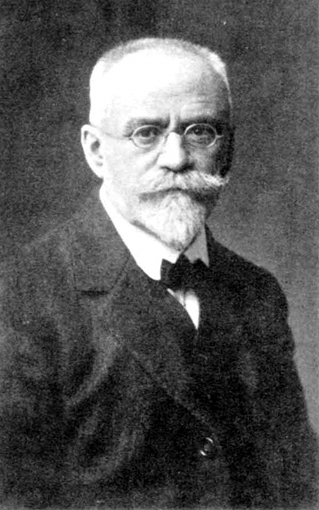 Joseph Deniker Furthermore, according to John Efron of Indiana University, the late 19th century also witnessed "the scientizing of anti-Jewish prejudice", stigmatizing Jews with male menstruation, pathological hysteria, and nymphomania.[89][90] At the same time, several Jews, such as Joseph Jacobs or Samuel Weissenberg, also endorsed the same pseudoscientific theories, convinced that the Jews formed a distinct race.[89][90] Chaim Zhitlovsky also attempted to define Yiddishkayt (Ashkenazi Jewishness) by turning to contemporary racial theory.[91] Joseph Deniker (1852–1918) was one of William Z. Ripley's principal opponents; whereas Ripley maintained, as did Vacher de Lapouge, that the European populace comprised three races, Joseph Deniker proposed that the European populace comprised ten races (six primary and four sub-races). Furthermore, he proposed that the concept of "race" was ambiguous, and in its stead proposed the compound word "ethnic group", which later prominently featured in the works of Julian Huxley and Alfred C. Haddon. Moreover, Ripley argued that Deniker's "race" idea should be denoted a "type", because it was less biologically rigid than most racial classifications. |
形質人類学における人種論(1850年~1918年) H.ストリックランド・コンスタブルによる19世紀末のイラストは、「アイルランドのイベリア人」と「黒人」の特徴の類似性を示し、より高い「アングロ・ チュートン人」とは対照的であると主張している。 カール・リンネによって確立された科学的分類は、人間の人種分類を行う上で必要不可欠なものである。19世紀、一系進化論(古典的社会進化論)とは、西 ヨーロッパ文化が人類の社会文化的進化の頂点であるとする、競合する社会学的・人類学的理論の混同であった。キリスト教の聖書は奴隷制を是認するものと解 釈され、1820年代から1850年代にかけて、前世紀アメリカ南部において、リチャード・ファーマン牧師やトーマス・R・コブ牧師などの作家によって、 黒人は劣った存在であり、それゆえに奴隷制に適した存在であるという考えを強制するためにしばしば使用された[67]。 アルチュール・ド・ゴビノー  ラ・トゥール伯爵夫人によるアルチュール・ド・ゴビノーの肖像、1876年 フランスの貴族であり作家であったアルチュール・ド・ゴビノー(1816-1882)は、3つの人種(黒人、白人、黄色人種)が自然の障壁であり、人種混 合は文化と文明の崩壊につながると主張した著書『An Essay on the Inequality of the Human Races』(1853-55)でよく知られている。彼は、「美、知性、力はもともと白人種が独占していた」とし、黒人やアジア人の積極的な業績や考え方 は白人との混血によるものだと主張した。彼の著作は、ジョサイア・C・ノットやヘンリー・ホッツェといった多くの白人至上主義的なアメリカの奴隷制推進思 想家たちから賞賛された。 ゴビノーは、白人はシベリアのどこかで、アジア人はアメリカ大陸で、黒人はアフリカで生まれたと信じていた。彼は白人種が優れていると考え、こう書いてい る: 宣教師や船長によって書かれた書物の中で、あるウォロフ人は立派な大工であり、あるホッテントット人は優れた使用人であり、あるカフィール人は踊り、ヴァ イオリンを弾き、あるバンバラは算数を知っている......このような戯言はさておき、人間同士ではなく、集団同士を比較しよう」[68]。 ゴビノーは後にゲルマン民族(la race germanique)を表現するために「アーリア人」という言葉を使った[69]。 ゴビノーの著作はナチ党にも影響を与え、ナチ党は彼の著作をドイツ語で出版した。ゴビノーの著作はナチス党にも影響を与え、ナチス党は彼の著作をドイツ語 で出版した。 カール・フォクト  1870年のカール・フォクト もう一人の多遺伝子進化論者はカール・フォクト(1817-1895)で、彼は黒人種族は類人猿に関係していると考えていた。彼は白人種は黒人とは別の種 であると書いた。彼は『人間講義』(1864年)の第7章で、黒人と白人を比較し、「2つの極端な人間型」と表現した。両者の違いは2種の猿の違いよりも 大きく、これは黒人が白人とは別の種であることを証明していると彼は主張した[70]。 チャールズ・ダーウィン  1868年のチャールズ・ダーウィン チャールズ・ダーウィンの人種に関する見解は、多くの議論と論争の的となっている。ジャクソンとワイドマンによれば、ダーウィンは19世紀の人種に関する 議論では穏健派であった。「ダーウィンは人種差別主義者ではなかったが、例えば、奴隷廃止論者であった。 ダーウィンの影響力のある1859年の著書『種の起源』では、人類の起源については論じていない。自然淘汰の手段によって、あるいは生命をめぐる闘争にお いて有利な種族が保存されることによって」と追加されたタイトルページの拡張された表現は、「例えばキャベツのいくつかの種族」のような「品種」の代替と しての生物学的種族という一般的な用語を使用しており、人間の種族という現代的な意味合いは含んでいない。The Descent of Man, and Selection in Relation to Sex』(1871年)において、ダーウィンは「いわゆる人間の種族を別個の種として位置づけることに賛成する論拠と反対する論拠」という問題を検討し、 人間の種族が別個の種であることを示すような人種的区別はないと報告している[67][72]。 歴史家のリチャード・ホフスタッターはこう書いている: ダーウィニズムは19世紀末の好戦的なイデオロギーと独断的な人種差別の主要な源ではなかったが、人種と闘争の理論家の手中にある新たな道具となっ た...。ダーウィニズムのムードは、19世紀後半に多くのアメリカ人思想家を夢中にさせたアングロサクソン人種の優越性への信念を支えた。人種」がすで に達成した世界支配の尺度は、それが適者であることを証明しているように思われた[73]。 歴史家のガートルード・ヒメルファーブによれば、「『種の起源』の副題は人種差別主義者にとって都合のよい標語となった。もちろん、ダーウィンは『種族』 を品種や種を意味するものと考えていたが、それを人間の種族にまで拡大することは、彼の意味に反するものではなかった......。ダーウィン自身は、奴 隷制を嫌っていたにもかかわらず、ある種族が他の種族よりも適しているという考えを嫌ってはいなかった」[74]。 一方、ロバート・バニスターは人種問題についてダーウィンを擁護し、「よく調べてみると、ダーウィン自身に不利なケースはすぐに解明される。彼は奴隷制度 に熱心に反対し、一貫して非白人の抑圧に反対していた。現代の基準からすると、『人間の下降』は人間の平等という重要な問題については結論が出ず、もどか しいが、世紀半ばの人種差別の状況においては、節度と科学的注意の模範であった」[75]。 ハーバート・ホープ・リスリー  ハーバート・ホープ・リスリー 「人種科学」の提唱者として、植民地行政官ハーバート・ホープ・リスリー(1851-1911)は、鼻の高さに対する鼻の幅の比率を用いて、インド人を アーリア人種とドラヴィダ人種、そして7つのカーストに分けた[76][77]。 エルンスト・ヘッケル  エルンスト・ヘッケル エルンスト・ヘッケル(1834-1919)は、ダーウィンを支持した多くの人々と同様に、言語学者で多言語学者であったアウグスト・シュライヒャーの考 えに基づいて、進化論的多言語主義の学説を提唱した。これらの別々の言語が動物から人間への移行を完了させ、それぞれの主要な言語群の影響を受けて、人間 は別個の種として進化し、種族に細分化されるようになった。ヘッケルは人類を10の人種に分け、そのうちコーカソイドが最高で、原始人は絶滅の運命にある とした[78]。ヘッケルはまた、人類の起源はアジアにあると書くことで、アジア外説の提唱者でもあった。ヘッケルは、人類は東南アジアの霊長類と密接な 関係があると主張し、アフリカのダーウィンの仮説を否定した[79][80]。 ヘッケルはまた、黒人は他のどの人種よりも強く、自由に動かせる足指を持っており、それは黒人が類人猿に関係している証拠であると書いている。ヘッケルは 黒人を「四つ手」の類人猿に例えた。ヘッケルはまた、黒人は野蛮人であり、白人が最も文明的であると考えていた[70]。 ラプージュとヘルダーによるナショナリズム 19世紀末、科学的人種主義は、グレコローマン優生思想とフランシス・ゴルトンの自発的優生学の概念を融合させ、他の社会政治的言説や出来事の影響を受け た強制的な反移民政府プログラムを生み出した。このような制度的人種差別は、人相学から性格を占う骨相学、頭蓋測定による頭蓋骨や骨格の研究、つまり黒人 やその他の有色人種の頭蓋骨や骨格が猿と白人の間に展示されることによって行われた。 1906年、ピグミーのオタ・ベンガは「ミッシング・リンク」として、ニューヨークのブロンクス動物園で類人猿や動物と一緒に展示された。最も影響力のあ る理論家としては、「人間社会学」を提唱した人類学者ジョルジュ・ヴァシェール・ド・ラプージュ(1854-1936)や、「人種」をナショナリズム理論 に応用し、民族ナショナリズムの最初の概念を構築したヨハン・ゴットフリート・ヘルダー(1744-1803)が挙げられる。1882年、エルネスト・ル ナンはヘルダーと対立し、民族的・人種的前提条件ではなく「共に生きようとする意志」に基づくナショナリズムを提唱した(市民ナショナリズムを参照)。科 学的な人種主義的言説は、ドイツのドイツ民族や、数千年前から存在する基本的な「アーリア民族」の一派である「フランス民族」のような「民族的人種」の歴 史的存在を仮定し、人種的国境と平行した地政学的国境を主張した。 頭蓋計測と身体人類学 さらに詳しい情報 頭蓋計測と身体人類学  ピーテル・カンパー オランダの学者ピーテル・カンパー(1722-89)は、初期の頭蓋測定理論家であり、人種差を科学的に正当化するために「頭蓋測定」(頭蓋骨内部の容積 測定)を用いた。1770年、彼は人間の種族間の知能を測定するために顔面角を考案した。顔面角は、鼻の穴から耳までの水平線と、顎骨上部の隆起から額の 隆起までの垂直線の2本を引くことで形成された。カンペールの頭蓋測定によれば、アンティークの彫像(グレコ・ローマ時代の理想像)の顔の角度は90度、 白人は80度、黒人は70度、オランウータンは58度であった。このような科学的人種差別研究は、博物学者エティエンヌ・ジェフロワ・サン・ヒレール (1772-1844)や人類学者ポール・ブローカ(1824-1880)によって続けられた。 サミュエル・ジョージ・モートン  人種主義者の違い 「黒人の頭......白人の頭蓋骨......モンゴルの頭」、サミュエル・ジョージ・モートン、1839年 19世紀、アメリカの初期の身体人類学者であり、医師であり、多人種学者であったサミュエル・ジョージ・モートン(1799-1851)は、世界中から人 間の頭蓋骨を収集し、論理的な分類法を試みた。現代の人種論に影響を受けたモートン博士は、頭蓋内部の容積を測定することで人種の知的能力を判断できると し、したがって頭蓋骨が大きければ脳が大きく、知的能力が高いことを示した。逆に頭蓋骨が小さいと脳が小さく、知的能力が低いことになる。モートンは、古 代エジプトの地下墓地から発見された3体のミイラを調査した結果、白人と黒人は3000年前にはすでに区別されていたと結論づけた。聖書の解釈では、ノア の方舟がアララト山に流れ着いたのはそのわずか1000年前であることから、モートンはノアの息子たちが地球上のすべての人種を占めることはあり得ないと 主張した。モートンの多系統発生説によれば、人種は最初から別々であった[81]。 モートンの『クラニア・アメリカーナ(Crania Americana)』において、彼の主張は頭蓋測定のデータに基づいており、白人は平均87立方インチの最も大きな脳を持ち、アメリカ先住民は平均82 立方インチの中間に位置し、黒人は平均78立方インチの最も小さな脳を持っていた[81]。  ジョサイア・クラーク・ノットとジョージ・ロビンズ・グリドンの著者は、「黒人」が「ギリシャ人」とチンパンジーの間に位置する創造的なランクであること を示唆した。 進化生物学者で科学史家のスティーヴン・ジェイ・グールドは、『The Mismeasure of Man』(1981年)の中で、サミュエル・モートンは頭蓋計測のデータを改ざんし、おそらく不注意から頭蓋骨を詰め込みすぎて、彼が証明しようとしてい た人種差別的な推定を正当化するような結果を生み出したのだと主張した。その後、人類学者のジョン・マイケルが行った研究では、モートンの元のデータは グールドの説明よりも正確であることが判明し、「グールドの解釈とは逆に...」と結論づけている。モートンの研究は誠実に行われていた」[82]。ジェ イソン・ルイスと同僚たちは、モートンの頭蓋骨コレクションの再分析においてマイケルと同様の結論に達したが、「現代人の変異は一般的に、バラバラであっ たり「人種的」であったりするのではなく連続的であり、現代人の変異のほとんどは集団間ではなく集団内にあることが研究によって実証されている」と付け加 えることによって、モートンの人種差別的な結論から逸脱している[83]。 1873年、パリの人類学会の創設者であるポール・ブローカ(1859年)は、剖検された標本の脳の重量を測定することによって、クラニア・アメリカーナ が報告したのと同じ測定パターンを発見した。黒人-白人、知能-脳の大きさの違いを提唱した他の歴史的研究には、ビーン(1906年)、モール(1909 年)、パール(1934年)、ヴィント(1934年)などがある。  ニコラス・パラシオス 太平洋戦争(1879年-83年)の後、チリの支配階級の間で人種的、民族的優越思想が台頭した[84]。 医師ニコラス・パラシオスは1918年の著書でチリ人の人種の存在と近隣の民族と比較したときの優越性を主張した。彼はチリ人は2つの武闘民族の混血であ ると考えた。先住民のマプーチェ族とスペインの西ゴート族であり、彼らは最終的にスウェーデンのゲータランドの子孫であった。パラシオスは南ヨーロッパの 血を引くメスティーソは「大脳のコントロール」を欠き、社会的な負担になると主張し、南ヨーロッパからチリへの移民に反対する医学的根拠を主張した [85]。 単遺伝主義と多遺伝主義(単元説と多元説) さらなる情報 単元主義と多元主義 サミュエル・モートンの支持者、特にジョサイア・C・ノット博士(1804-1873)とジョージ・グリドン博士(1809-1857)は、『人類の種 類』(1854年)の中でモートン博士の考えを拡張し、モートンの発見が現代の人類多地域起源仮説の前身である多遺伝主義(人類は別々の遺伝的祖先を持 ち、人種は進化的に無関係である)の概念を支持していると主張しました。さらにモートン自身は、多遺伝子説を支持することに消極的であった。なぜなら、多 遺伝子説は神学的に聖書で唱えられるキリスト教の創造神話に反するからである。 その後、チャールズ・ダーウィンは『人間の下降』(1871年)の中で、単一起源仮説、すなわち人類は共通の遺伝的祖先を持っており、種族は関連している という一元論を提唱し、ノットとグリドンが提唱した多遺伝子主義のすべてに反対した。 類型論  セファリック・インデックス ウィリアム・Z・リプリーのヨーロッパ頭位指数地図、The Races of Europe (1899)。 さまざまな人種を分類するために使われた最初の類型論のひとつは、優生学の理論家ジョルジュ・ヴァシェール・ド・ラプージュ(1854~1936)が考案 したもので、彼は1899年に『アーリア人とその社会的役割』(L'Aryen et son rôle social)を出版した。この本の中で、彼は人類をさまざまな階層化された人種に分類し、その範囲は「アーリア人の白色人種、長頭人種」から「短頭人 種」、「平凡で不活発な」人種、南ヨーロッパのカトリック農民に最もよく代表される人種にまで及んだ[86]。 ラプージュによれば、ユダヤ人はアーリア人と同じ長頭性であったが、それゆえに彼は彼らを危険な存在とみなした。 ヴァシュ・ド・ラプージュの分類は、アメリカの白人至上主義に大きな影響を与えたウィリアム・Z・リプリーの『ヨーロッパの人種』(1899年)に反映さ れている。リプリーは、ヨーロッパ住民の頭骨指数に基づくヨーロッパ地図まで作成した。彼はアメリカの優生学者マディソン・グラントに重要な影響を与え た。  ジョセフ・デニカー さらに、インディアナ大学のジョン・エフロンによれば、19世紀後半には「反ユダヤ偏見の科学化」も見られ、ユダヤ人に男性月経、病的ヒステリー、ニン フォマニアの汚名を着せた。 [同時に、ジョセフ・ジェイコブズやサミュエル・ヴァイセンベルクのような何人かのユダヤ人もまた同じ偽科学的な理論を支持し、ユダヤ人が別個の人種を形 成していると確信していた[89][90]。 チャイム・ジトロフスキーもまた、現代の人種理論に目を向けることによってイディシュカイト(アシュケナージ系ユダヤ人)を定義しようとした[91]。 ジョセフ・デニカー(1852年-1918年)はウィリアム・Z・リプリーの主要な反対者の一人であった。リプリーがヴァシュ・ド・ラプージュと同様に ヨーロッパの民衆は3つの人種から構成されていると主張していたのに対し、ジョセフ・デニカーはヨーロッパの民衆は10の人種(6つの主要人種と4つの亜 人種)から構成されていると提唱した。さらに彼は、「人種」という概念は曖昧であるとし、その代わりに「民族グループ」という複合語を提案した。さらにリ プリーは、デニカーの「人種」概念は、ほとんどの人種分類よりも生物学的に厳密でないため、「タイプ」と呼ぶべきだと主張した。 |
Ideological applications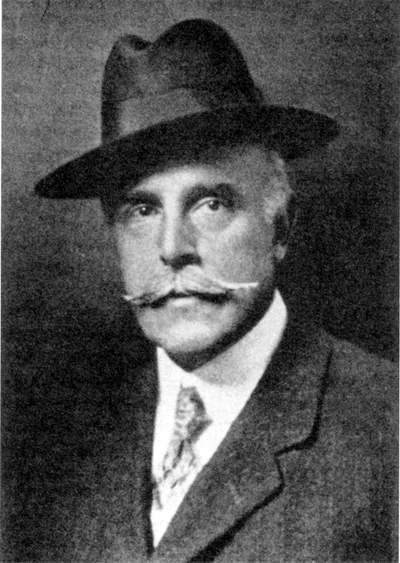 Madison Grant, creator of the Nordic race term Nordicism Joseph Deniker's contribution to racist theory was La Race nordique (the Nordic race), a generic, racial-stock descriptor, which the American eugenicist Madison Grant (1865–1937) presented as the white racial engine of world civilization. Having adopted Ripley's three-race European populace model, but disliking the Teuton race name, he transliterated la race nordique into 'the Nordic race', the acme of the concocted racial hierarchy, based upon his racial classification theory, popular in the 1910s and 1920s. The State Institute for Racial Biology (Swedish: Statens Institut för Rasbiologi) and its director Herman Lundborg in Sweden were active in racist research. Furthermore, much of early research on Ural-Altaic languages was coloured by attempts at justifying the view that European peoples east of Sweden were Asian and thus of an inferior race, justifying colonialism, eugenics and racial hygiene.[citation needed] The book The Passing of the Great Race (Or, The Racial Basis of European History) by American eugenicist, lawyer, and amateur anthropologist Madison Grant was published in 1916. Though influential, the book was largely ignored when it first appeared, and it went through several revisions and editions. Nevertheless, the book was used by people who advocated restricted immigration as justification for what became known as scientific racism.[92] Justification of slavery in the United States  Samuel Cartwright, M.D. In the United States, scientific racism justified Black African slavery to assuage moral opposition to the Atlantic slave trade. Alexander Thomas and Samuell Sillen described black men as uniquely fitted for bondage, because of their "primitive psychological organization."[93] In 1851, in antebellum Louisiana, the physician Samuel A. Cartwright (1793–1863) wrote of slave escape attempts as "drapetomania," a treatable mental illness, that "with proper medical advice, strictly followed, this troublesome practice that many Negroes have of running away can be almost entirely prevented." The term drapetomania (mania of the runaway slave) derives from the Greek δραπέτης (drapetes, 'a runaway [slave]') and μανία (mania, 'madness, frenzy').[94] Cartwright also described dysaesthesia aethiopica, called "rascality" by overseers. The 1840 United States Census claimed that Northern, free blacks suffered mental illness at higher rates than did their Southern, enslaved counterparts. Though the census was later found to have been severely flawed by the American Statistical Association, it became a political weapon against abolitionists. Southern slavers concluded that escaping Negroes were suffering from "mental disorders."[95] At the time of the American Civil War (1861–1865), the matter of miscegenation prompted studies of ostensible physiological differences between Caucasians and Negroes. Early anthropologists, such as Josiah Clark Nott, George Robins Gliddon, Robert Knox, and Samuel George Morton, aimed to scientifically prove that Negroes were a human species different from the white people; that the rulers of Ancient Egypt were not African; and that mixed-race offspring (the product of miscegenation) tended to physical weakness and infertility. After the Civil War, Southern (Confederacy) physicians wrote textbooks of scientific racism based upon studies claiming that black freemen (ex-slaves) were becoming extinct, because they were inadequate to the demands of being a free man—implying that black people benefited from enslavement. In Medical Apartheid, Harriet A. Washington noted the prevalence of two different views on blacks in the 19th century: the belief that they were inferior and "riddled with imperfections from head to toe", and the idea that they did not know true pain and suffering because of their primitive nervous systems (and that slavery was therefore justifiable). Washington noted the failure of scientists to accept the inconsistency between these two viewpoints, writing that: in the eighteenth and nineteenth centuries, scientific racism was simply science, and it was promulgated by the very best minds at the most prestigious institutions of the nation. Other, more logical medical theories stressed the equality of Africans and laid poor black health at the feet of their abusers, but these never enjoyed the appeal of the medical philosophy that justified slavery and, along with it, our nation's profitable way of life.[96] Even after the end of the Civil War, some scientists continued to justify the institution of slavery by citing the effect of topography and climate on racial development. Nathaniel Shaler, a prominent geologist at Harvard University from 1869 to 1906, published the book Man and the Earth in 1905 describing the physical geography of different continents and linking these geologic settings to the intelligence and strength of human races that inhabited these spaces. Shaler argued that North American climate and geology was ideally suited for the institution of slavery.[97] South African apartheid See also: Carnegie Commission on the Poor White Problem in South Africa Scientific racism played a role in establishing apartheid in South Africa. In South Africa, white scientists, like Dudly Kidd, who published The essential Kafir in 1904, sought to "understand the African mind". They believed that the cultural differences between whites and blacks in South Africa might be caused by physiological differences in the brain. Rather than suggesting that Africans were "overgrown children", as early white explorers had, Kidd believed that Africans were "misgrown with a vengeance". He described Africans as at once "hopelessly deficient", yet "very shrewd".[98] The Carnegie Commission on the Poor White Problem in South Africa played a key role in establishing apartheid in South Africa. According to one memorandum sent to Frederick Keppel, then president of the Carnegie Corporation, there was "little doubt that if the natives were given full economic opportunity, the more competent among them would soon outstrip the less competent whites".[99] Keppel's support for the project of creating the report was motivated by his concern with the maintenance of existing racial boundaries.[99] The preoccupation of the Carnegie Corporation with the so-called poor white problem in South Africa was at least in part the outcome of similar misgivings about the state of poor whites in the southern United States.[99] The report was five volumes in length.[100] Around the start of the 20th century, white Americans, and whites elsewhere in the world, felt uneasy because poverty and economic depression seemed to strike people regardless of race.[100] Though the ground work for apartheid began earlier, the report provided support for this central idea of black inferiority. This was used to justify racial segregation and discrimination[101] in the following decades.[102] The report expressed fear about the loss of white racial pride, and in particular pointed to the danger that the poor white would not be able to resist the process of "Africanisation".[99] Although scientific racism played a role in justifying and supporting institutional racism in South Africa, it was not as important in South Africa as it has been in Europe and the United States. This was due in part to the "poor white problem", which raised serious questions for supremacists about white racial superiority.[98] Since poor whites were found to be in the same situation as natives in the African environment, the idea that intrinsic white superiority could overcome any environment did not seem to hold. As such, scientific justifications for racism were not as useful in South Africa.[98] Eugenics Further information: Eugenics 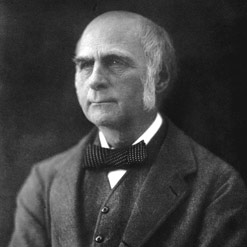 Francis Galton in his later years Stephen Jay Gould described Madison Grant's The Passing of the Great Race (1916) as "the most influential tract of American scientific racism." In the 1920s–30s, the German racial hygiene movement embraced Grant's Nordic theory. Alfred Ploetz (1860–1940) coined the term Rassenhygiene in Racial Hygiene Basics (1895), and founded the German Society for Racial Hygiene in 1905. The movement advocated selective breeding, compulsory sterilization, and a close alignment of public health with eugenics. Racial hygiene was historically tied to traditional notions of public health, but with emphasis on heredity—what philosopher and historian Michel Foucault has called state racism. In 1869, Francis Galton (1822–1911) proposed the first social measures meant to preserve or enhance biological characteristics, and later coined the term eugenics. Galton, a statistician, introduced correlation and regression analysis and discovered regression toward the mean. He was also the first to study human differences and inheritance of intelligence with statistical methods. He introduced the use of questionnaires and surveys to collect data on population sets, which he needed for genealogical and biographical works and for anthropometric studies. Galton also founded psychometrics, the science of measuring mental faculties, and differential psychology, a branch of psychology concerned with psychological differences between people rather than common traits. Like scientific racism, eugenics grew popular in the early 20th century, and both ideas influenced Nazi racial policies and Nazi eugenics. In 1901, Galton, Karl Pearson (1857–1936) and Walter F. R. Weldon (1860–1906) founded the Biometrika scientific journal, which promoted biometrics and statistical analysis of heredity. Charles Davenport (1866–1944) was briefly involved in the review. In Race Crossing in Jamaica (1929), he made statistical arguments that biological and cultural degradation followed white and black interbreeding. Davenport was connected to Nazi Germany before and during World War II. In 1939 he wrote a contribution to the festschrift for Otto Reche (1879–1966), who became an important figure within the plan to remove populations considered "inferior" from eastern Germany.[103] |
イデオロギーへの応用 マディソン・グラント、北欧人種という言葉の生みの親 北欧主義 ジョセフ・デニカーが人種主義理論に貢献したのは、アメリカの優生学者マディソン・グラント(1865-1937)が世界文明の白人人種の原動力として提 示した、一般的な人種ストックの記述語であるLa Race nordique(北欧人種)であった。リプリーのヨーロッパ3人種モデルを採用した彼は、チュートン人種の名称を嫌い、la race nordiqueを「北欧人種」と訳し、1910年代から1920年代にかけて流行した彼の人種分類理論に基づく、でっち上げられた人種ヒエラルキーの頂 点とした。 スウェーデンの国立人種生物学研究所(Statens Institut för Rasbiologi)とその所長ヘルマン・ランドボルグは、人種差別研究に積極的だった。さらに、ウラル・アルタイ諸語に関する初期の研究の多くは、ス ウェーデン以東のヨーロッパ人はアジア人であり、したがって劣等人種であるという見解を正当化し、植民地主義、優生学、人種衛生学を正当化しようとする試 みによって彩られていた[citation needed] アメリカの優生学者、弁護士、アマチュア人類学者マディソン・グラントによる著書『The Passing of the Great Race (Or, The Racial Basis of European History)』は1916年に出版された。影響力はあったものの、出版当初はほとんど無視され、何度か改訂版が出版された。それにもかかわらず、この 本は科学的人種差別として知られるようになったものを正当化するものとして、移民制限を主張する人々によって利用された[92]。 アメリカにおける奴隷制の正当化  医師サミュエル・カートライト アメリカでは、科学的人種差別主義が、大西洋奴隷貿易に対する道徳的反対を和らげるために、アフリカ黒人の奴隷制を正当化した。アレクサンダー・トーマス とサミュエル・シレンは、「原始的な心理組織」[93]のために、黒人男性は奴隷制度に独特に適していると説明した。1851年、前世のルイジアナにおい て、医師のサミュエル・A・カートライト(1793-1863)は、奴隷の逃亡未遂を「ドラペトマニア(drapetomania)」として、治療可能な 精神病であり、「適切な医学的助言を厳格に守れば、多くの黒人が持っているこの厄介な逃亡行為は、ほとんど完全に防ぐことができる」と書いた。ドラペトマ ニア(家出奴隷の躁病)という用語はギリシャ語のδραπέτης(drapetes、「家出した[奴隷]」)とμανία(mania、「狂気、狂 乱」)に由来する[94]。 カートライトはまた、監督によって「悪戯」と呼ばれた感覚異常(dysaesthesia aethiopica)についても記述している。1840年のアメリカ合衆国国勢調査では、北部の自由黒人は南部の奴隷であった黒人よりも高い割合で精神 疾患を患っていたと主張した。この国勢調査は後にアメリカ統計協会によって重大な欠陥があることが判明したが、奴隷廃止論者に対する政治的武器となった。 南部の奴隷商人たちは、逃亡した黒人は「精神障害」に苦しんでいると結論づけた[95]。 アメリカ南北戦争(1861年-1865年)当時、混血の問題は白人と黒人の間の表向きの生理学的差異の研究を促した。ジョサイア・クラーク・ノット、 ジョージ・ロビンス・グリドン、ロバート・ノックス、サミュエル・ジョージ・モートンといった初期の人類学者は、黒人が白人とは異なる人類種であること、 古代エジプトの支配者はアフリカ人ではなかったこと、混血の子孫(混血の産物)は身体が弱く不妊の傾向があることを科学的に証明することを目的としてい た。南北戦争後、南部(連合国)の医師たちは、黒人の自由人(元奴隷)は絶滅しつつあり、それは彼らが自由人としての要求を満たすのに不十分だからだと主 張する研究に基づいて、科学的人種差別の教科書を書いた。 ハリエット・A・ワシントンは、『医学的アパルトヘイト』の中で、19世紀における黒人に対する2つの異なる見解の蔓延を指摘している。すなわち、黒人は 劣等であり、「頭のてっぺんからつま先まで欠陥だらけ」であるという信念と、原始的な神経系のため真の痛みや苦しみを知らない(したがって奴隷制は正当化 される)という考え方である。ワシントンは、科学者たちがこの2つの視点の矛盾を受け入れなかったことを指摘し、次のように書いている: 18世紀と19世紀において、科学的人種差別は単なる科学であり、国家の最も権威ある機関の最も優秀な頭脳によって広められた。他の、より論理的な医学理 論は、アフリカ人の平等を強調し、黒人の健康状態の悪さを虐待者の足元に置いていたが、それらは奴隷制を正当化する医学哲学の魅力を享受することはなく、 それとともに、わが国の有益な生活様式を正当化していた[96]。 南北戦争が終わった後も、地形や気候が人種の発達に及ぼす影響を引き合いに出して、奴隷制度を正当化する科学者がいた。1869年から1906年までハー バード大学で著名な地質学者であったナサニエル・シェイラーは、1905年に『人間と地球』という本を出版し、さまざまな大陸の物理的地形を説明し、これ らの地質環境とこれらの空間に居住していた人類の知性と強さを関連づけた。シェイラーは、北米の気候と地質が奴隷制度に理想的に適していると主張した [97]。 南アフリカのアパルトヘイト 以下も参照: 南アフリカの貧困白人問題に関するカーネギー委員会 科学的人種差別は、南アフリカにおけるアパルトヘイトの確立に一役買った。南アフリカでは、1904年に『The essential Kafir』を出版したダドリー・キッドのような白人科学者が「アフリカ人の心を理解」しようとした。彼らは、南アフリカにおける白人と黒人の文化的な違 いは、脳の生理学的な違いによって引き起こされているのではないかと考えた。キッドは、初期の白人探検家のようにアフリカ人が「成長しすぎた子供」である と示唆するのではなく、アフリカ人は「復讐に燃えて成長し間違えた」のだと考えた。彼はアフリカ人を「絶望的に欠落している」と同時に「非常に抜け目がな い」と評した[98]。 南アフリカの貧困白人問題に関するカーネギー委員会は、南アフリカにおけるアパルトヘイトの確立に重要な役割を果たした。当時カーネギー公社の社長であっ たフレデリック・ケッペルに送られたある覚書によれば、「原住民に十分な経済的機会が与えられれば、彼らの中で能力の高い者が能力の低い白人をすぐに凌駕 することはほとんど疑いない」[99]。 [カーネギー公社が南アフリカのいわゆる貧困白人問題に夢中になったのは、少なくとも部分的には、アメリカ南部の貧困白人の状態に対する同様の懸念の結果 であった[99]。 20世紀初頭、アメリカの白人や世界の他の地域の白人は、貧困や経済不況が人種に関係なく人々を襲っているように見えたため、不安を感じていた [100]。 アパルトヘイトの下地作りはそれ以前から始まっていたが、この報告書は黒人の劣等性というこの中心的な考えを支持するものとなった。報告書は、白人の人種 的誇りが失われることへの恐れを表明し、特に貧しい白人が「アフリカ化」のプロセスに抵抗できなくなる危険性を指摘していた[99]。 科学的人種主義は、南アフリカにおける制度的人種主義を正当化し支持する役割を果たしたが、南アフリカではヨーロッパやアメリカほど重要ではなかった。こ れは「貧しい白人問題」のせいでもあり、白人至上主義者たちに白人の人種的優位性についての深刻な疑問を投げかけた[98]。貧しい白人はアフリカの環境 において原住民と同じ状況にあることが判明したため、本質的な白人の優位性がどのような環境にも打ち勝つことができるという考えは成立しないように思われ た。そのため、人種差別の科学的正当化は南アフリカではそれほど有用ではなかった[98]。 優生学 さらなる情報 優生学  晩年のフランシス・ガルトン(あるいはゴルトン) スティーヴン・ジェイ・グールドは、マディソン・グラントの『The Passing of the Great Race』(1916年)を「アメリカの科学的人種差別の最も影響力のある書物」と評した。1920年代から30年代にかけて、ドイツの人種衛生運動はグ ラントのノルディック理論を受け入れた。アルフレッド・プロッツ(1860-1940)は『人種衛生の基本』(1895)の中でラッセンハイジーン (Rassenhygiene)という言葉を作り、1905年にドイツ人種衛生協会を設立した。この運動は、選択的繁殖、強制不妊手術、公衆衛生と優生学 の密接な連携を提唱した。 人種衛生は歴史的に伝統的な公衆衛生の概念と結びついていたが、遺伝に重点を置いたものであり、哲学者・歴史家のミシェル・フーコーが国家人種差別と呼ん だものである。1869年、フランシス・ガルトン(1822-1911)は、生物学的特徴を維持または強化することを意図した最初の社会的措置を提案し、 後に優生学という言葉を生み出した。統計学者であったガルトンは、相関分析と回帰分析を導入し、平均への回帰を発見した。彼はまた、統計学的手法を用いて 人間の違いや知能の遺伝を研究した最初の人物でもある。彼は、系図や伝記、人体計測の研究に必要な母集団のデータを収集するために、アンケートや調査を導 入した。ガルトンはまた、精神能力を測定する科学である心理測定学と、共通の特徴よりもむしろ人々の間の心理的差異に関係する心理学の一分野である差異心 理学を創設した。 科学的人種差別と同様に、優生学も20世紀初頭に人気を博し、両者の考え方はナチスの人種政策やナチスの優生学に影響を与えた。1901年、ガルトン、 カール・ピアソン(1857-1936)、ウォルター・F・R・ウェルドン(1860-1906)は、バイオメトリクスと遺伝の統計分析を推進する科学雑 誌『バイオメトリカ』を創刊した。チャールズ・ダヴェンポート(1866-1944)も短期間ながら審査に携わった。ジャマイカにおける人種交配』 (1929年)の中で、彼は白人と黒人の交配には生物学的・文化的劣化がつきまとうという統計的主張を行った。ダベンポートは、第二次世界大戦前と戦時中 にナチス・ドイツと関係があった。1939年、彼はオットー・レチェ(1879-1966)の記念式典に寄稿し、彼はドイツ東部から「劣等」とみなされる 人々を排除する計画の中で重要な人物となった[103]。 |
| Interbellum to World War II Scientific racism continued through the early 20th century, and soon intelligence testing became a new source for racial comparisons. Before World War II (1939–45), scientific racism remained common to anthropology, and was used as justification for eugenics programs, compulsory sterilization, anti-miscegenation laws, and immigration restrictions in Europe and the United States. The war crimes and crimes against humanity of Nazi Germany (1933–45) discredited scientific racism in academia,[citation needed] but racist legislation based upon it remained in some countries until the late 1960s. Early intelligence testing and the Immigration Act of 1924 Before the 1920s, social scientists agreed that whites were superior to blacks, but they needed a way to prove this to back social policy in favor of whites. They felt the best way to gauge this was through testing intelligence. By interpreting the tests to show favor to whites these test makers' research results portrayed all minority groups very negatively.[15][104] In 1908, Henry Goddard translated the Binet intelligence test from French and in 1912 began to apply the test to incoming immigrants on Ellis Island.[105] Some claim that in a study of immigrants Goddard reached the conclusion that 87% of Russians, 83% of Jews, 80% of Hungarians, and 79% of Italians were feeble-minded and had a mental age less than 12.[106] Some have also claimed that this information was taken as "evidence" by lawmakers and thus it affected social policy for years.[107] Bernard Davis has pointed out that, in the first sentence of his paper, Goddard wrote that the subjects of the study were not typical members of their groups but were selected because of their suspected sub-normal intelligence. Davis has further noted that Goddard argued that the low IQs of the test subjects were more likely due to environmental rather than genetic factors, and that Goddard concluded that "we may be confident that their children will be of average intelligence and if rightly brought up will be good citizens".[108] In 1996 the American Psychological Association's Board of Scientific Affairs stated that IQ tests were not discriminatory towards any ethnic/racial groups.[109] In his book The Mismeasure of Man, Stephen Jay Gould argued that intelligence testing results played a major role in the passage of the Immigration Act of 1924 that restricted immigration to the United States.[110] However, Mark Snyderman and Richard J. Herrnstein, after studying the Congressional Record and committee hearings related to the Immigration Act, concluded "the [intelligence] testing community did not generally view its findings as favoring restrictive immigration policies like those in the 1924 Act, and Congress took virtually no notice of intelligence testing".[111] Juan N. Franco contested the findings of Snyderman and Herrnstein. Franco stated that even though Snyderman and Herrnstein reported that the data collected from the results of the intelligence tests were in no way used to pass The Immigration Act of 1924, the IQ test results were still taken into consideration by legislators. As suggestive evidence, Franco pointed to the following fact: Following the passage of the immigration act, information from the 1890 census was used to set quotas based on percentages of immigrants coming from different countries. Based on these data, the legislature restricted the entrance of immigrants from southern and eastern Europe into the United States and allowed more immigrants from northern and Western Europe into the country. The use of the 1900, 1910 or 1920 census data sets would have resulted in larger numbers of immigrants from southern and eastern Europe being allowed into the U.S. However, Franco pointed out that using the 1890 census data allowed congress to exclude southern and eastern Europeans (who performed worse on IQ tests of the time than did western and northern Europeans) from the U.S. Franco argued that the work Snyderman and Herrnstein conducted on this matter neither proved or disproved that intelligence testing influenced immigration laws.[112] Sweden  The Swedish State Institute for Racial Biology, founded in 1922, was the world's first government-funded institute performing research into racial biology. It was housed in what is now the Dean's house at Uppsala and was closed down in 1958. Following the creation of the first society for the promotion of racial hygiene, the German Society for Racial Hygiene in 1905—a Swedish society was founded in 1909 as the Svenska sällskapet för rashygien, the third in the world.[113][114] By lobbying Swedish parliamentarians and medical institutes the society managed to pass a decree creating a government-run institute in the form of the Swedish State Institute for Racial Biology in 1921.[113] By 1922 the institute was built and opened in Uppsala.[113] It was the first such government-funded institute in the world performing research into "racial biology" and remains highly controversial to this day.[113][115] It was the most prominent institution for the study of "racial science" in Sweden.[116] The goal was to cure criminality, alcoholism and psychiatric problems through research in eugenics and racial hygiene.[113] As a result of the institute's work, a law permitting compulsory sterilization of certain groups was enacted in Sweden in 1934.[117] The second president of the institute Gunnar Dahlberg was highly critical of the validity of the science performed at the institute and reshaped the institute toward a focus on genetics.[118] In 1958 it closed down and all remaining research was moved to the Department of Medical Genetics at Uppsala University.[118] Nazi Germany Main article: Racial policy of Nazi Germany  Nazi poster promoting eugenics The Nazi Party and its sympathizers published many books on scientific racism, seizing on the eugenicist and antisemitic ideas with which they were widely associated, although these ideas had been in circulation since the 19th century. Books such as Rassenkunde des deutschen Volkes ("Racial Science of the German People") by Hans Günther[119] (first published in 1922)[120] and Rasse und Seele ("Race and Soul") by Ludwig Ferdinand Clauß [de][121] (published under different titles between 1926 and 1934)[122]: 394 attempted to scientifically identify differences between the German, Nordic, or Aryan people and other, supposedly inferior, groups.[citation needed] German schools used these books as texts during the Nazi era.[123] In the early 1930s, the Nazis used racialized scientific rhetoric based on social Darwinism[citation needed] to push its restrictive and discriminatory social policies. During World War II, Nazi racialist beliefs became anathema in the United States, and Boasians such as Ruth Benedict consolidated their institutional power. After the war, discovery of the Holocaust and Nazi abuses of scientific research (such as Josef Mengele's ethical violations and other war crimes revealed at the Nuremberg Trials) led most of the scientific community to repudiate scientific support for racism. Propaganda for the Nazi eugenics program began with propaganda for eugenic sterilization. Articles in Neues Volk described the appearance of the mentally ill and the importance of preventing such births.[124] Photographs of mentally incapacitated children were juxtaposed with those of healthy children.[125]: 119 The film Das Erbe showed conflict in nature to legitimate the Law for the Prevention of Hereditarily Diseased Offspring by sterilization. Although the child was "the most important treasure of the people", this did not apply to all children, even German ones, only to those with no hereditary weaknesses.[126] Nazi Germany's racially based social policies placed the improvement of the Aryan race through eugenics at the center of Nazis ideology. Those humans were targeted who were identified as "life unworthy of life" (German: Lebensunwertes Leben), including but not limited to Jewish people, criminals, degenerate, dissident, feeble-minded, homosexual, idle, insane, and the weak, for elimination from the chain of heredity.[citation needed] Although they were still regarded as "Aryan", Nazi ideology deemed Slavs (i.e., Poles, Russians, Ukrainians, etc.) to be racially inferior to the Germanic master race, suitable for expulsion, enslavement, or even extermination.[127]: 180 Adolf Hitler banned intelligence quotient (IQ) testing for being "Jewish".[128]: 16 United States  Lothrop Stoddard (1883–1950) In the 20th century, concepts of scientific racism, which sought to prove the physical and mental inadequacy of groups deemed "inferior", was relied upon to justify involuntary sterilization programs.[129][130] Such programs, promoted by eugenicists such as Harry H. Laughlin, were upheld as constitutional by the U.S. Supreme Court in Buck v. Bell (1927). In all, between 60,000 and 90,000 Americans were subjected to involuntary sterilization.[129] Scientific racism was also used as a justification for the Emergency Quota Act of 1921 and the Immigration Act of 1924 (Johnson–Reed Act), which imposed racial quotas limiting Italian American immigration to the United States and immigration from other southern European and eastern European nations. Proponents of these quotas, who sought to block "undesirable" immigrants, justifying restrictions by invoking scientific racism.[131] Lothrop Stoddard published many racialist books on what he saw as the peril of immigration, his most famous being The Rising Tide of Color Against White World-Supremacy in 1920. In this book he presented a view of the world situation pertaining to race focusing concern on the coming population explosion among the "colored" peoples of the world and the way in which "white world-supremacy" was being lessened in the wake of World War I and the collapse of colonialism. Stoddard's analysis divided world politics and situations into "white", "yellow", "black", "Amerindian", and "brown" peoples and their interactions. Stoddard argued race and heredity were the guiding factors of history and civilization, and that the elimination or absorption of the "white" race by "colored" races would result in the destruction of Western civilization. Like Madison Grant, Stoddard divided the white race into three main divisions: Nordic, Alpine, and Mediterranean. He considered all three to be of good stock, and far above the quality of the colored races, but argued that the Nordic was the greatest of the three and needed to be preserved by way of eugenics. Unlike Grant, Stoddard was less concerned with which varieties of European people were superior to others (Nordic theory), but was more concerned with what he called "bi-racialism", seeing the world as being composed of simply "colored" and "white" races. In the years after the Great Migration and World War I, Grant's racial theory would fall out of favor in the U.S. in favor of a model closer to Stoddard's.[citation needed] An influential publication was The Races of Europe (1939) by Carleton S. Coon, president of the American Association of Physical Anthropologists from 1930 to 1961. Coon was a proponent of multiregional origin of modern humans. He divided Homo sapiens into five main races: Caucasoid, Mongoloid (including Native Americans), Australoid, Congoid, and Capoid. Coon's school of thought was the object of increasing opposition in mainstream anthropology after World War II. Ashley Montagu was particularly vocal in denouncing Coon, especially in his Man's Most Dangerous Myth: The Fallacy of Race. By the 1960s, Coon's approach had been rendered obsolete in mainstream anthropology, but his system continued to appear in publications by his student John Lawrence Angel as late as in the 1970s. In the late 19th century, the Plessy v. Ferguson (1896) United States Supreme Court decision—which upheld the constitutional legality of racial segregation under the doctrine of "separate but equal"—was intellectually rooted in the racism of the era, as was the popular support for the decision.[132] Later, in the mid-20th century, the Supreme Court's Brown v. Board of Education of Topeka (1954) decision rejected racialist arguments about the "need" for racial segregation—especially in public schools. |
インターベラムから第二次世界大戦まで 科学的人種差別は20世紀初頭まで続き、やがて知能検査が人種比較の新たな資料となった。第二次世界大戦(1939-45年)以前は、科学的人種差別は人 類学に共通するものであり、ヨーロッパやアメリカにおける優生学プログラム、強制不妊手術、混血防止法、移民制限の正当化として用いられた。ナチス・ドイ ツ(1933-45年)の戦争犯罪と人道に対する罪により、学術界では科学的人種差別主義は信用されなくなったが[要出典]、一部の国では1960年代後 半まで人種差別主義に基づく法律が残っていた。 初期の知能検査と1924年の移民法 1920年代以前、社会科学者は白人が黒人より優れていることに同意していたが、白人に有利な社会政策を支持するために、それを証明する方法が必要だっ た。それを測る最良の方法は、知能テストだと考えたのである。1908年、ヘンリー・ゴダールはビネー式知能検査をフランス語から翻訳し、1912年にエ リス島で入国してきた移民にこの検査を適用し始めた[105]。ゴダールが移民を調査した結果、ロシア人の87%、ユダヤ人の83%、ハンガリー人の 80%、イタリア人の79%が気が弱く、精神年齢が12歳未満であるという結論に達したという主張もある[106]。 [バーナード・デイヴィスは、論文の最初の文章で、ゴダードは研究の対象者はその集団の典型的なメンバーではなく、正常でない知能が疑われたために選ばれ たと書いていることを指摘している。デイヴィスはさらに、ゴダードは被験者のIQが低いのは遺伝的要因というよりもむしろ環境的要因による可能性が高いと 主張し、ゴダードは「彼らの子どもは平均的な知能を持ち、正しく育てば善良な市民になると確信してもよい」と結論づけていると指摘している[108]。 1996年、アメリカ心理学会の科学委員会は、IQテストはいかなる民族/人種集団に対しても差別的ではないと述べている[109]。 スティーヴン・ジェイ・グールドはその著書『The Mismeasure of Man』の中で、知能テストの結果が、アメリカへの移民を制限する1924年の移民法の成立に大きな役割を果たしたと主張している[110]。しかし、 マーク・スナイダーマンとリチャード・J・ハーンシュタインは、移民法に関連する議会の記録と委員会の公聴会を調査した結果、「(知能)テストのコミュニ ティは一般的に、その調査結果が1924年の法律のような制限的な移民政策を支持するものだとは考えておらず、議会は知能テストについて事実上何の関心も 持たなかった」と結論づけている[111]。 Juan N. FrancoはSnydermanとHerrnsteinの調査結果に異議を唱えた。フランコは、スナイダーマンとハーンシュタインが、知能テストの結果 から収集されたデータが1924年の移民法の可決に利用されることはなかったと報告しているにもかかわらず、IQテストの結果は立法者によって考慮された と述べている。移民法の成立後、1890年の国勢調査の情報は、さまざまな国からの移民の割合に基づいた割当を設定するために使われた。これらのデータに 基づいて、議会は南ヨーロッパと東ヨーロッパからの移民の入国を制限し、北ヨーロッパと西ヨーロッパからの移民の入国を許可した。しかし、フランコは、 1890年の国勢調査のデータを使用することによって、議会が(当時のIQテストにおいて西欧人や北欧人よりも成績が悪かった)南欧人や東欧人をアメリカ から排除することができたと指摘している。フランコは、この問題についてスナイダーマンとハーンシュタインが行った研究は、知能テストが移民法に影響を与 えたことを証明するものでも反証するものでもないと主張している[112]。 スウェーデン  1922年に設立されたスウェーデン国立人種生物学研究所は、人種生物学の研究を行う世界初の政府出資の研究所であった。現在のウプサラの学長公邸に入居 していたが、1958年に閉鎖された。 1905年に人種衛生を促進するための最初の学会であるドイツ人種衛生学会が設立されたのに続き、1909年にはスウェーデンの学会が世界で3番目となる Svenska sällskapet för rashygienとして設立された[113][114]。 [1922年までにウプサラに研究所が建設され、開設された[113][113]。 [その目的は、優生学と人種衛生の研究を通じて犯罪やアルコール依存症、精神疾患を治療することであった[113][116]。 研究所の研究の結果、1934年にスウェーデンで特定の集団の強制不妊手術を許可する法律が制定された。 [1958年に研究所は閉鎖され、残りの研究はすべてウプサラ大学の医学遺伝学部に移された[118]。 ナチス・ドイツ 主な記事 ナチス・ドイツの人種政策  優生学を宣伝するナチスのポスター ナチ党とそのシンパは、優生思想や反ユダヤ主義的な思想が19世紀から流布していたにもかかわらず、それらと広く結びついた科学的人種主義に関する多くの 書籍を出版した。ハンス・ギュンターによる『ドイツ民族の人種科学』(Rassenkunde des deutschen Volkes)[119](初版は1922年)[120]やルートヴィヒ・フェルディナント・クラウスによる『人種と魂』(Rasse und Seele)[de][121](1926年から1934年にかけて異なる題名で出版された)[122]といった書物である: 394はドイツ人、北欧 人、アーリア人と他の劣等とされる集団との違いを科学的に特定しようとした[要出典]。1930年代初頭、ナチスは制限的で差別的な社会政策を推し進める ために、社会ダーウィニズム[要出典]に基づく人種的科学的レトリックを用いた。 第二次世界大戦中、ナチスの人種主義的信念はアメリカでは忌み嫌われるようになり、ルース・ベネディクトのようなボアジアンは組織的な権力を強化した。戦 後、ホロコーストやナチスによる科学研究の濫用(ヨーゼフ・メンゲレの倫理違反やニュルンベルク裁判で明らかになったその他の戦争犯罪など)が発覚し、科 学界の大半は人種差別に対する科学的支持を否定するようになった。 ナチスの優生プログラムのプロパガンダは、優生不妊手術のプロパガンダから始まった。Neues Volk』誌の記事は、精神障害者の外見とそのような出生を防ぐことの重要性を記述していた[124]。精神障害児の写真は健康な子どもの写真と並置され ていた[125]: 119 映画『Das Erbe』は、不妊手術による遺伝性疾患子孫防止法を正当化するために、自然における対立を示した。 子どもは「国民の最も重要な宝物」であったが、これはすべての子ども、たとえドイツ人であっても、遺伝性の弱点のない子どもだけに適用されたわけではな かった[126]。ナチス・ドイツの人種に基づく社会政策は、優生学によるアーリア人種の改良をナチス・イデオロギーの中心に据えた。ユダヤ人、犯罪者、 堕落した者、反体制的な者、気の弱い者、同性愛者、怠け者、精神異常者、弱者など、「生きるに値しない生命」(ドイツ語: Lebensunwertes Leben)とみなされた人間が、遺伝の連鎖から排除される対象とされた[要出典]、 ポーランド人、ロシア人、ウクライナ人など)は人種的にゲルマン人の主人種よりも劣っており、追放、奴隷化、あるいは絶滅に適していると考えた [127]: 180 アドルフ・ヒトラーは「ユダヤ人」であることを理由に知能指数(IQ)テストを禁止した[128]: 16 アメリカ合衆国  ロスロップ・ストッダード(1883~1950年) 20世紀には、「劣っている」とみなされた集団の肉体的・精神的な不十分さを証明しようとする科学的人種差別の概念が、非自発的不妊化プログラムを正当化 するために依拠された[129][130]。ハリー・H・ラフリンなどの優生学者が推進したこのようなプログラムは、バック対ベル事件(1927年)にお いて連邦最高裁判所によって合憲として支持された。全部で60,000人から90,000人のアメリカ人が強制不妊手術の対象となった[129]。 科学的人種主義もまた、1921年の緊急割当法と1924年の移民法(ジョンソン・リード法)の正当化として使用された。この法律は、アメリカへのイタリ ア系アメリカ人の移民と他の南ヨーロッパや東ヨーロッパ諸国からの移民を制限する人種割当を課した。これらの割当の支持者は、「望ましくない」移民を阻止 しようとし、科学的人種差別を持ち出して制限を正当化した[131]。 ロスロップ・ストッダードは移民の危険性について多くの人種主義的な本を出版したが、彼の最も有名な本は1920年に出版された『The Rising Tide of Color Against White World-Supremacy (白人至上主義に対する有色人種の上昇する潮流)』である。この本で彼は、人種に関わる世界情勢について、世界の「有色人種」の間で人口爆発が起こるこ と、そして第一次世界大戦と植民地主義の崩壊をきっかけに「白人の世界至上主義」が弱まりつつあることに焦点を当てた見解を示した。 ストッダードの分析は、世界の政治と状況を「白人」、「黄色人種」、「黒人」、「アメリカインディアン」、「褐色人種」とその相互作用に分けた。ストッ ダードは、人種と遺伝が歴史と文明の指導的要因であり、「有色人種」による「白人」の排除や吸収は西洋文明の破壊につながると主張した。マディソン・グラ ントと同様、ストッダードは白人種を大きく3つに分けた: 北欧系、アルプス系、地中海系である。ストッダードは、この3つの人種はいずれも優良な血統であり、有色人種よりも遥かに優れた資質を持っていると考えた が、ノルディックが3つの中で最も優れており、優生学によって保存する必要があると主張した。グラントとは異なり、ストッダードはヨーロッパ人のどの種族 が他の種族より優れているか(ノルディック説)にはあまり関心を示さず、世界を単に「有色人種」と「白人」で構成されていると見なす、彼が「両人種主義」 と呼ぶものに関心を寄せていた。大移動と第一次世界大戦後の数年間で、グラントの人種論はアメリカでは支持されなくなり、ストッダードに近いモデルが支持 されるようになる[要出典]。 影響力のある出版物は、1930年から1961年までアメリカ人類物理学会の会長であったカールトン・S・クーンによる『ヨーロッパの人種』(1939 年)である。クーンは現生人類の多地域起源説を唱えた。彼はホモ・サピエンスを大きく5つの人種に分けた: コーカソイド、モンゴロイド(ネイティブ・アメリカンを含む)、オーストラロイド、コンゴイド、カポイドである。 クーンの学派は、第二次世界大戦後、人類学の主流派から反発を受けるようになった。アシュレー・モンタグは、特に『人間の最も危険な神話:人種の誤謬』 (Man's Most Dangerous Myth: The Fallacy of Race)の中で、声高にクーンを非難した。1960年代までに、クーンのアプローチは人類学の主流派からは廃れてしまったが、彼の弟子であるジョン・ ローレンス・エンジェルの出版物には、1970年代になっても彼の体系が登場し続けていた。 19世紀後半、プレッシー対ファーガソン事件(1896年)の合衆国最高裁判決は、「分離しているが平等である」という原則の下、人種隔離の合憲性を支持 したが、この判決に対する大衆の支持と同様に、この時代の人種主義に知的に根ざしていた[132]。その後、20世紀半ば、ブラウン対トピカ教育委員会事 件(1954年)の最高裁判決は、特に公立学校における人種隔離の「必要性」についての人種主義的議論を否定した。 |
| After 1945 By 1954, 58 years after the Plessy v. Ferguson upholding of racial segregation in the United States, American popular and scholarly opinions of scientific racism and its sociologic practice had evolved.[132] In 1960, the journal Mankind Quarterly was founded, which is commonly described as a venue for scientific racism and white supremacy,[133][134][135] and as lacking a legitimate scholarly purpose.[136] The journal was founded in 1960, partly in response to the Supreme Court decision Brown v. Board of Education which desegregated the American public school system.[137][136] In April 1966, Alex Haley interviewed American Nazi Party founder George Lincoln Rockwell for Playboy. Rockwell justified his belief that blacks were inferior to whites by citing a long 1916 study by G. O. Ferguson which claimed to show that the intellectual performance of black students was correlated with their percentage of white ancestry, stating "pure negroes, negroes three-fourths pure, mulattoes and quadroons have, roughly, 60, 70, 80 and 90 percent, respectively, of white intellectual efficiency".[138] Playboy later published the interview with an editorial note claiming the study was a "discredited ... pseudoscientific rationale for racism".[139] International bodies such as UNESCO attempted to draft resolutions that would summarize the state of scientific knowledge about race and issued calls for the resolution of racial conflicts. In its 1950 "The Race Question", UNESCO did not reject the idea of a biological basis to racial categories,[140] but instead defined a race as: "A race, from the biological standpoint, may therefore be defined as one of the group of populations constituting the species Homo sapiens", which were broadly defined as the Caucasian, Mongoloid, Negroid races but stated that "It is now generally recognized that intelligence tests do not in themselves enable us to differentiate safely between what is due to innate capacity and what is the result of environmental influences, training and education."[141] Despite scientific racism being largely dismissed by the scientific community after World War II, some researchers have continued to propose theories of racial superiority in the past few decades.[142][143] These authors themselves, while seeing their work as scientific, may dispute the term racism and may prefer terms such as "race realism" or "racialism".[144] In 2018, British science journalist and author Angela Saini expressed strong concern about the return of these ideas into the mainstream.[145] Saini followed up on this idea with her 2019 book Superior: The Return of Race Science.[146] One such post-World War II scientific racism researcher is Arthur Jensen. His most prominent work is The g Factor: The Science of Mental Ability in which he supports the theory that black people are inherently less intelligent than whites. Jensen argues for differentiation in education based on race, stating that educators must "take full account of all the facts of [students'] nature."[147] Responses to Jensen criticized his lack of emphasis on environmental factors.[148] Psychologist Sandra Scarr describes Jensen's work as "conjur[ing] up images of blacks doomed to failure by their own inadequacies".[149] J. Philippe Rushton, president of the Pioneer Fund (Race, Evolution, and Behavior) and a defender of Jensen's The g Factor,[150] also has multiple publications perpetuating scientific racism. Rushton argues "race differences in brain size likely underlie their multifarious life history outcomes."[151] Rushton's theories are defended by other scientific racists such as Glayde Whitney. Whitney published works suggesting higher crime rates among people of African descent can be partially attributed to genetics.[152] Whitney draws this conclusion from data showing higher crime rates among people of African descent across different regions. Other researchers point out that proponents of a genetic crime-race link are ignoring confounding social and economic variables, drawing conclusions from correlations.[153] Christopher Brand was a proponent of Arthur Jensen's work on racial intelligence differences.[154] Brand's The g Factor: General Intelligence and Its Implications claims black people are intellectually inferior to whites.[155] He argues the best way to combat IQ disparities is to encourage low-IQ women to reproduce with high-IQ men.[155] He faced intense public backlash, with his work being described as a promotion of eugenics.[156] Brand's book was withdrawn by the publisher and he was dismissed from his position at the University of Edinburgh. 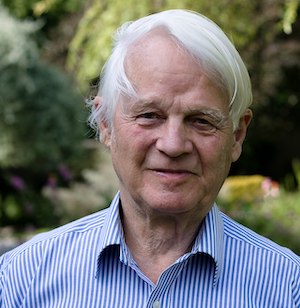 Richard Lynn (1930–2023) Psychologist Richard Lynn has published multiple papers and a book supporting theories of scientific racism. In IQ and the Wealth of Nations, Lynn claims that national GDP is determined largely by national average IQ.[157] He draws this conclusion from the correlation between average IQ and GDP and argues low intelligence in African nations is the cause of their low levels of growth. Lynn's theory has been criticized for attributing causal relationship between correlated statistics.[158][159] Lynn supports scientific racism more directly in his 2002 paper "Skin Color and Intelligence in African Americans", where he proposes "the level of intelligence in African Americans is significantly determined by the proportion of Caucasian genes."[160] As with IQ and the Wealth of Nations, Lynn's methodology is flawed, and he purports a causal relationship from what is simply correlation.[161] Other prominent modern proponents of scientific racism include Charles Murray and Richard Herrnstein (The Bell Curve); and Nicholas Wade (A Troublesome Inheritance). Wade's book faced strong backlash from the scientific community, with 142 geneticists and biologists signing a letter describing Wade's work as "misappropriation of research from our field to support arguments about differences among human societies."[162] On June 17, 2020, Elsevier announced it was retracting an article that J. Philippe Rushton and Donald Templer had published in 2012 in the Elsevier journal Personality and Individual Differences.[163] The article falsely claimed that there was scientific evidence that skin color was related to aggression and sexuality in humans.[164] The Jena Declaration, published by the German Zoological Society, rejects the idea of human races and distances itself from the racial theories of 20th century scientists. It states that genetic variation between human populations is smaller than within them, demonstrating that the biological concept of "races" is invalid. The statement highlights that there are no specific genes or genetic markers that match with conventional racial categorizations. It also indicates that the idea of "races" is based on racism rather than any scientific factuality.[165][166] Clarence Gravlee writes that disparities in the incidence of such medical conditions as diabetes, stroke, cancer, and low birth weight should be viewed with a societal lens. He argues that social inequalities, not genetic differences between races, are the reason for these differences. He writes that genetic differences between different population groups are based on climate and geography, not race, and he calls for replacing incorrect biological explanations of racial disparities with an analysis of the social conditions that lead to disparate medical outcomes.[167] In his book Is Science Racist, Jonathan Marks similarly asserts that races exist, though they lack a natural categorization in the realm of biology. Cultural rules such as the "one-drop rule" must be devised to establish categories of race, even if they go against the natural patterns within our species. According to Marks' writing, racist ideas propagated by scientists are what make science racist.[168] In her book Medical Apartheid[169] Harriet Washington describes the abuse of Black people in medical research and experimentation. Black people were tricked into participating in medical experiments through the use of unclear language on consent forms and a failure to list the risks and side effects of the treatment. Washington mentions that, because Black people were denied adequate health care, they were often desperate for medical help, and medical experimenters were able to exploit that need. Washington also emphasizes that when treatments were perfected and refined as a result of those experiments, Black people almost never benefited from the treatments.[170] A 2018 statement by the American Society of Human Genetics (ASHG) expressed alarm at the "resurgence of groups rejecting the value of genetic diversity and using discredited or distorted genetic concepts to bolster bogus claims of white supremacy." The ASHG denounced this as a "misuse of genetics to feed racist ideologies", and highlighted several factual errors upon which white supremacist claims have been based. The statement affirms that genetics "demonstrates that humans cannot be divided into biologically distinct subcategories" and that it "exposes the concept of 'racial purity'' as scientifically meaningless."[171] |
1945年以降 プレッシー対ファーガソン事件によってアメリカにおける人種隔離が支持されてから58年後の1954年までに、科学的人種差別とその社会学的実践に対する アメリカの大衆的・学者的意見は発展していた[132]。 1960年に雑誌『Mankind Quarterly』が創刊されたが、この雑誌は一般的に科学的人種差別と白人至上主義の場であり[133][134][135]、正当な学術的目的を欠 いていると評されている[136]。 1966年4月、アレックス・ヘイリーはプレイボーイのためにアメリカのナチ党創設者ジョージ・リンカーン・ロックウェルにインタビューした。ロックウェ ルは、黒人の生徒の知的能力は白人の祖先の割合と相関関係があると主張するG.O.ファーガソンによる1916年の長い研究を引用することによって、黒人 が白人よりも劣っているという彼の信念を正当化した。 [138]。後にプレイボーイは、この研究は「人種差別のための信用できない......疑似科学的な根拠」であると主張する論説を添えてインタビューを 掲載した[139]。 ユネスコのような国際機関は、人種に関する科学的知識の状況を要約する決議を起草し、人種対立の解決を呼びかけることを試みた。1950年の『人種問題』 において、ユネスコは人種分類に生物学的根拠があるという考えを否定せず[140]、代わりに人種を次のように定義した: 「人種は、生物学的見地から、ホモ・サピエンスという種を構成する集団のひとつと定義することができる。 科学的人種主義が第二次世界大戦後に科学界によってほとんど否定されたにもかかわらず、一部の研究者は過去数十年にわたり人種的優越性の理論を提案し続け ている[142][143]。 これらの著者自身は、自分たちの研究を科学的なものと見なしつつも、人種主義という用語に異論を唱え、「人種実在論」や「人種主義」といった用語を好むこ とがある[144]。 2018年、イギリスの科学ジャーナリストであり作家であるアンジェラ・サイニは、このような考え方が主流に戻ることについて強い懸念を表明した [145]。 サイニはこの考えに続き、2019年に著書『Superior: The Return of Race Science』(人種科学の帰還)[146]。 そのような第二次世界大戦後の科学的人種差別研究者の一人がアーサー・ジェンセンである。彼の最も著名な著作は『g因子』である: The Science of Mental Ability)で、黒人は白人よりも本質的に知能が低いという説を支持している。ジェンセンは人種に基づく教育の差別化を主張し、教育者は「(生徒の) 本性に関するすべての事実を十分に考慮しなければならない」と述べている[147]。 ジェンセンに対する反応は、彼が環境的要因を重視していないことを批判している[148]。 心理学者のサンドラ・スカールはジェンセンの研究を「黒人は自分自身の不十分さによって失敗する運命にあるというイメージを思い起こさせる」と評している [149]。 J. パイオニア基金(人種、進化、行動)の会長であり、ジェンセンの『g因子』の擁護者であるフィリップ・ラシュトン[150]もまた、科学的人種差別を永続 させる複数の出版物を持っている。ラシュトンは「脳の大きさにおける人種差は、おそらく多種多様な生活史的結果の根底にある」と主張している[151]。 ラシュトンの理論は、グレイデ・ホイットニーのような他の科学的人種差別主義者によって擁護されている。ホイットニーは、アフリカ系の人々の犯罪率が高い のは、部分的には遺伝に起因すると示唆する著作を発表している[152]。ホイットニーは、さまざまな地域でアフリカ系の人々の犯罪率が高いことを示す データからこの結論を導き出している。他の研究者は、遺伝的犯罪と人種の関連性の支持者は、交絡する社会的・経済的変数を無視しており、相関関係から結論 を導き出していると指摘している[153]。 クリストファー・ブランドはアーサー・ジェンセンの人種間の知能差に関する研究の支持者であった[154]: 彼はIQ格差に対抗する最善の方法は、IQの低い女性がIQの高い男性と繁殖することを奨励することであると主張している[155]。 彼は世論の激しい反発に直面し、彼の研究は優生学の推進であると評された[156]。  リチャード・リン(1930-2023) 心理学者リチャード・リンは、科学的人種差別の理論を支持する複数の論文と本を出版した。IQ and the Wealth of Nations(IQと国富論)』の中でリンは、国のGDPは国の平均IQによって大きく左右されると主張している[157]。彼は平均IQとGDPの相 関関係からこの結論を導き出し、アフリカ諸国の知能の低さが低成長の原因であると主張している。リンの理論は相関する統計の間に因果関係があるとして批判 されている[158][159]。リンは2002年の論文「アフリカ系アメリカ人の肌の色と知能」において科学的人種差別をより直接的に支持しており、そ こでは「アフリカ系アメリカ人の知能レベルは白人遺伝子の割合によって有意に決定される」と提唱している[160]。IQや国富論と同様に、リンの方法論 には欠陥があり、彼は単なる相関関係であるものを因果関係と称している[161]。 科学的人種差別の他の著名な現代的支持者には、チャールズ・マーレイとリチャード・ハーンシュタイン(『ベル・カーブ』)、ニコラス・ウェイド(『厄介な 遺伝』)などがいる。ウェイドの著書は科学界からの強い反発に直面し、142人の遺伝学者や生物学者がウェイドの研究を「人間社会の違いについての議論を 支持するために我々の分野の研究を流用した」とする書簡に署名した[162]。 2020年6月17日、エルゼビア社は、J.フィリップ・ラシュトンとドナルド・テンプラーが2012年にエルゼビア社の学術誌『Personality and Individual Differences』に発表した論文を撤回すると発表した[163]。この論文は、肌の色がヒトの攻撃性とセクシュアリティに関係しているという科学 的証拠があると偽っていた[164]。 ドイツ動物学会が発表したイエナ宣言は、人間の人種という考え方を否定し、20世紀の科学者の人種理論から距離を置いている。同宣言は、ヒトの集団間の遺 伝的変異は集団内よりも小さく、「人種」という生物学的概念が無効であることを示している。この声明は、従来の人種分類に合致する特定の遺伝子や遺伝マー カーが存在しないことを強調している。また、「人種」という考え方が、科学的事実よりもむしろ人種主義に基づいていることを示している[165] [166]。 クラレンス・グラヴリーは、糖尿病、脳卒中、癌、低体重児出産といった医学的状態の発生率における格差は、社会的なレンズで見るべきだと書いている。彼 は、人種間の遺伝的差異ではなく、社会的不平等がこうした差異の原因であると主張している。彼は、異なる集団間の遺伝的な違いは、人種ではなく、気候や地 理に基づいていると書き、人種間の格差の誤った生物学的な説明を、医学的転帰の格差につながる社会的条件の分析に置き換えることを求めている[167]。 ジョナサン・マークスは、著書『科学は人種差別的か』の中で、生物学の領域では自然な分類を欠いているが、人種は存在すると同様に主張している。人種とい うカテゴリーを確立するためには、「ワン・ドロップ・ルール」のような文化的ルールが考案されなければならない。マークスの文章によれば、科学者によって 広められた人種差別的な考えこそが、科学を人種差別的なものにしているのである[168]。 ハリエット・ワシントンはその著書『Medical Apartheid』[169]の中で、医学研究と実験における黒人の虐待について述べている。同意書に不明瞭な文言が使われたり、治療のリスクや副作用 が記載されなかったりすることで、黒人は騙されて医学実験に参加させられた。ワシントンは、黒人は適切な医療を拒否されていたため、しばしば医療の助けを 切実に求めており、医学実験者たちはその必要性を利用することができたと述べている。ワシントンはまた、そうした実験の結果、治療法が完成し、改良された としても、黒人がその治療の恩恵を受けることはほとんどなかったと強調している[170]。 アメリカ人類遺伝学会(ASHG)による2018年の声明は、"遺伝的多様性の価値を否定し、白人至上主義のインチキな主張を補強するために、信用できな い、あるいは歪曲された遺伝概念を利用するグループの復活 "に警鐘を鳴らしている。ASHGはこれを「人種差別イデオロギーを助長するための遺伝学の悪用」と非難し、白人至上主義者の主張の根拠となっているいく つかの事実誤認を強調した。この声明は、遺伝学が「ヒトを生物学的に異なるサブカテゴリーに分けることはできないことを証明している」と断言し、「『人種 の純粋性』という概念が科学的に無意味であることを暴露している」と述べている[171]。 |
| Bias Biological determinism Environmental determinism Freak show History of the race and intelligence controversy Human zoo Institute for the Study of Academic Racism Italian Fascism and racism Italian racial laws Nazism and race Objectification Pioneer Fund Racial policy of Nazi Germany Race and genetics Race and health Race and intelligence Scientific imperialism |
バイアス 生物学的決定論 環境決定論 見世物小屋(Freak show) 人種と知能論争の歴史 人間動物園 アカデミック人種主義研究所 イタリアのファシズムと人種差別 イタリアの人種法 ナチズムと人種 対象化 パイオニア基金 ナチス・ドイツの人種政策 人種と遺伝学 人種と健康 人種と知能 科学的帝国主義 |
| https://en.wikipedia.org/wiki/Scientific_racism |
|
リ ンク
文 献
そ の他の情報
Copyleft, CC, Mitzub'ixi Quq Chi'j, 1996-2099

☆
 ☆
☆